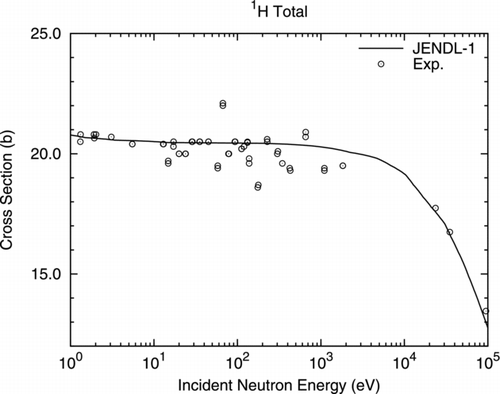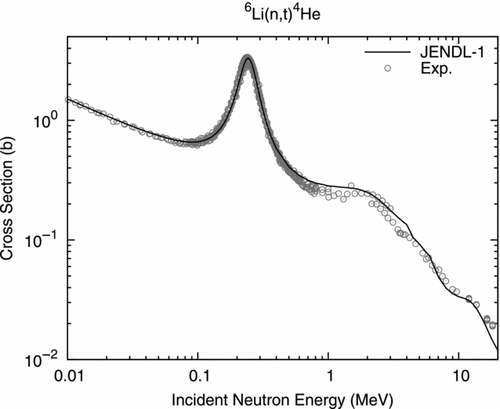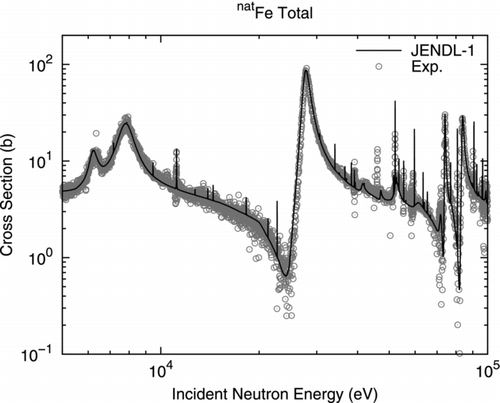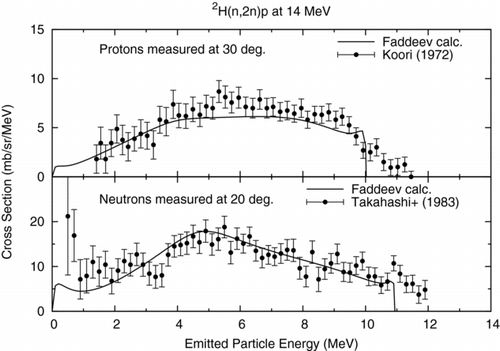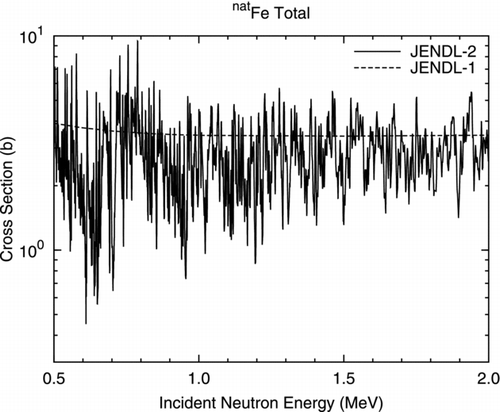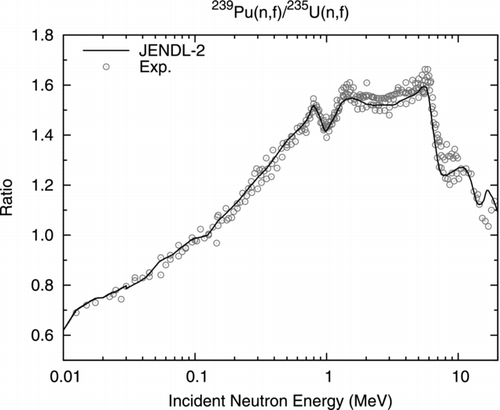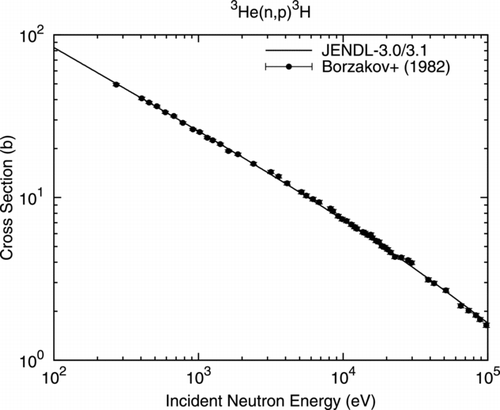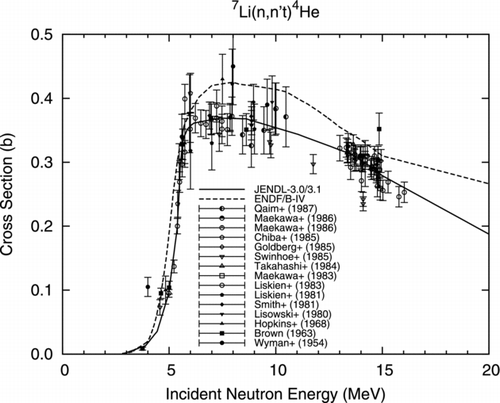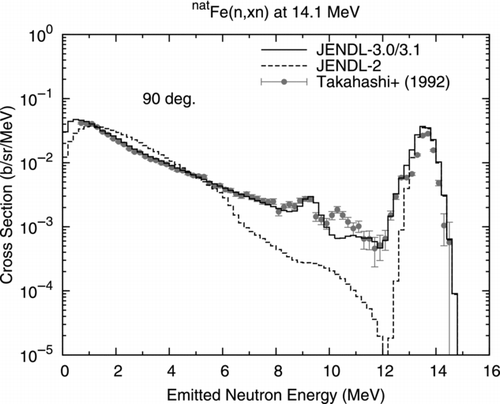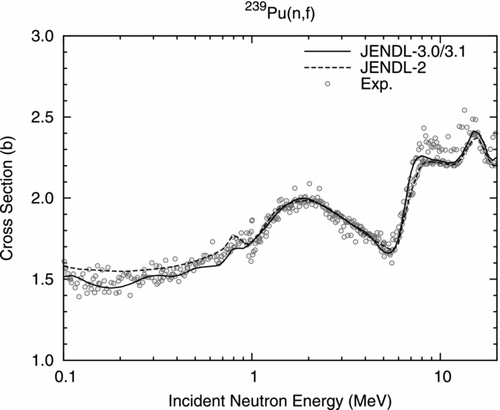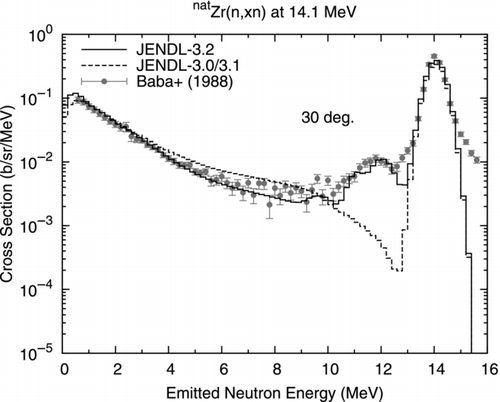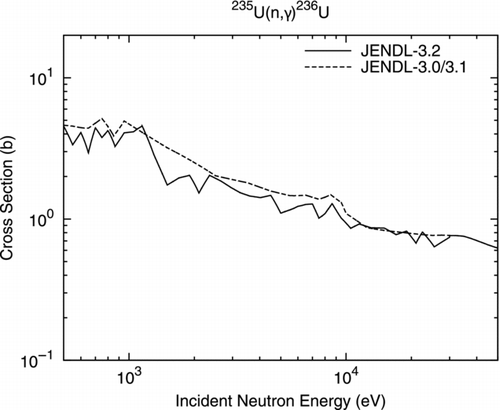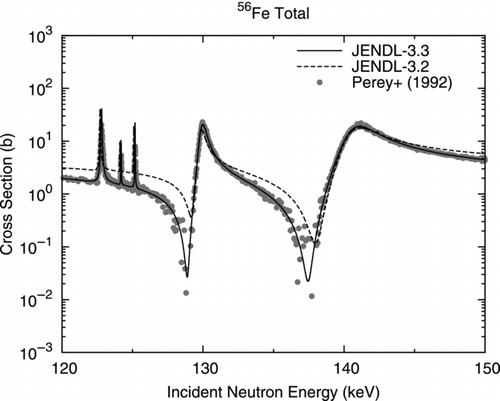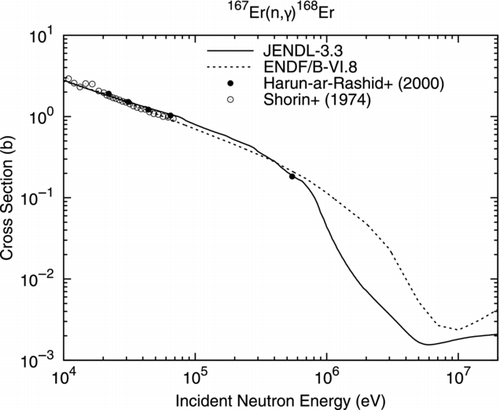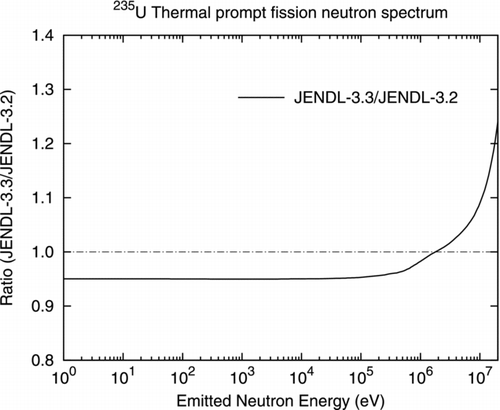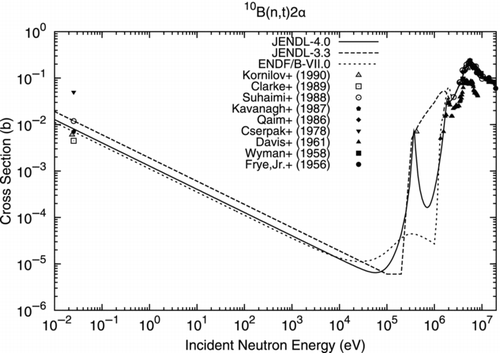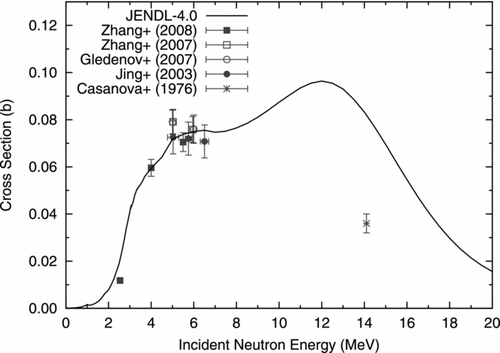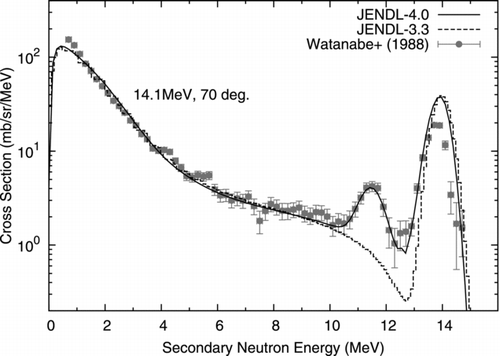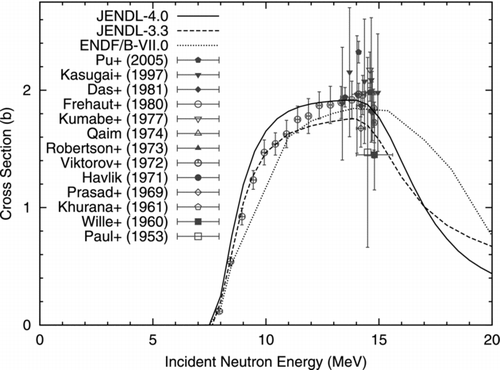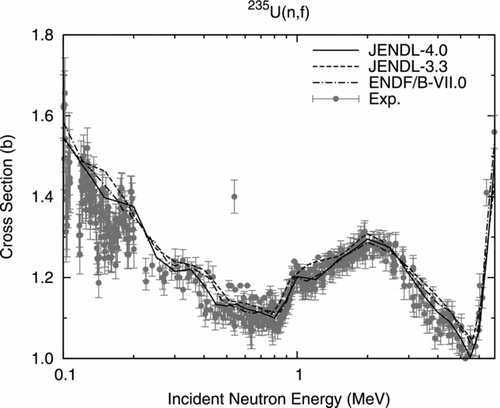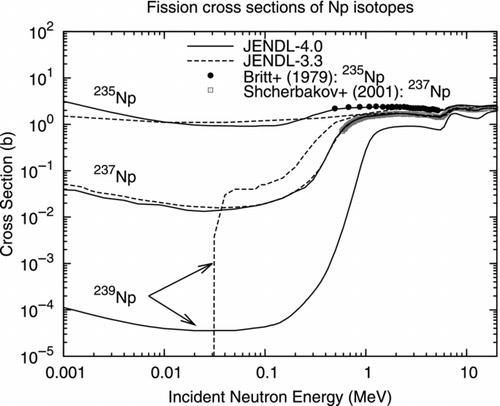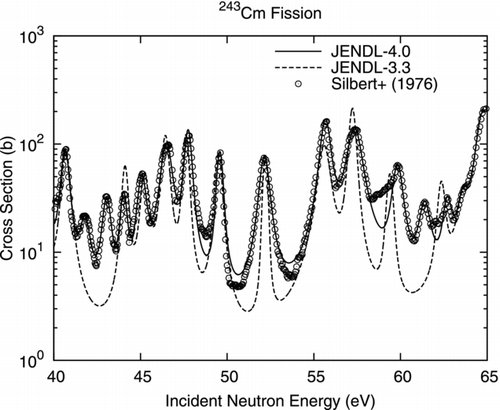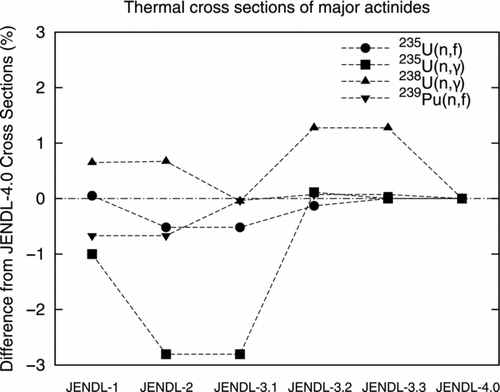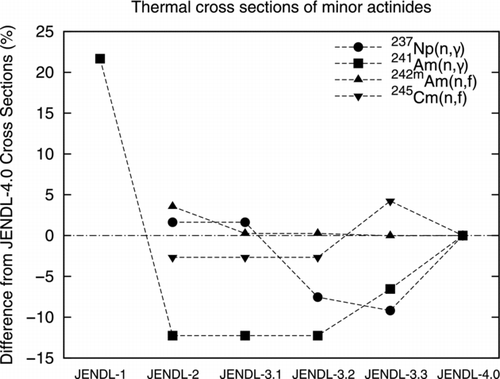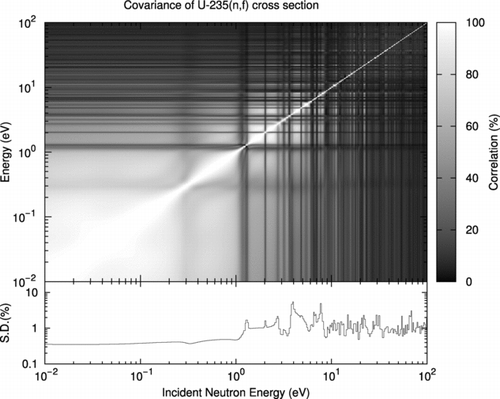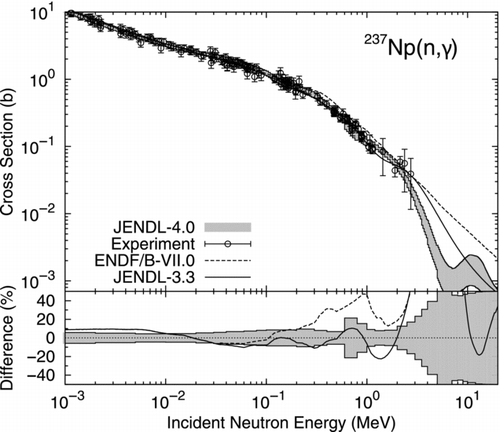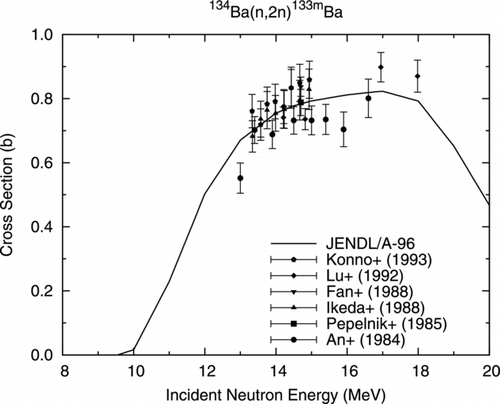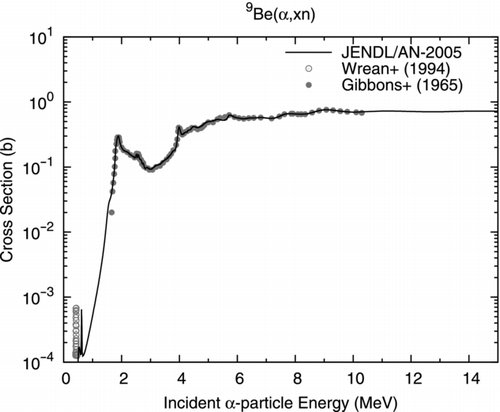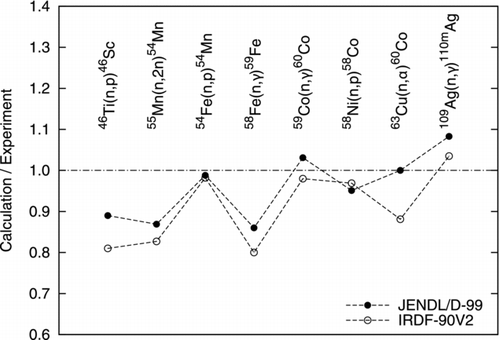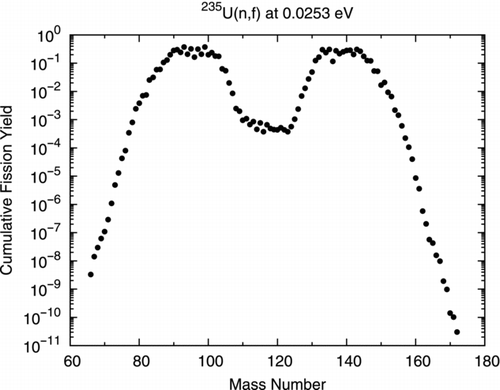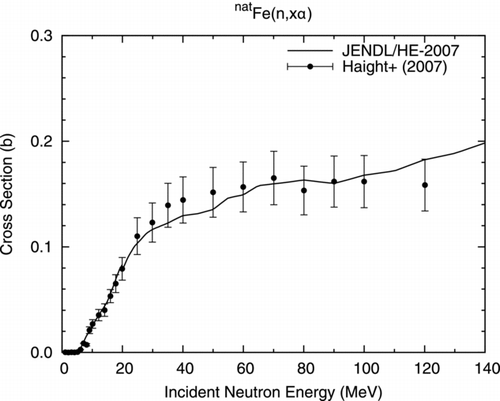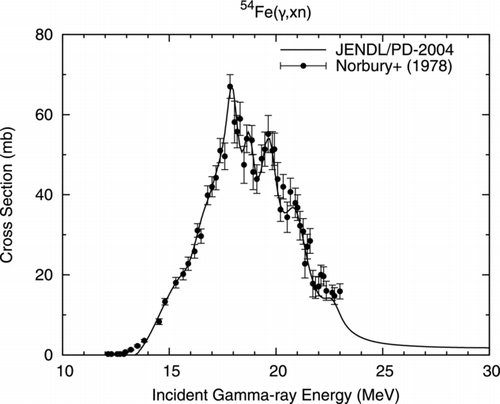Abstract
It is exactly 50 years since the Japanese Nuclear Data Committee was founded both in the Atomic Energy Society of Japan and in the former Japan Atomic Energy Research Institute. The committee promoted the development of Japan’s own evaluated nuclear data libraries. As a result, we managed to produce a series of Japanese Evaluated Nuclear Data Libraries (JENDLs) to be used in various fields for science and technology. The libraries are categorized into general-purpose and special-purpose ones. The general-purpose libraries have been updated periodically by considering the latest knowledge on experimental and theoretical nuclear physics that was available at the time of the updates. On the other hand, the special-purpose libraries have been issued in order to meet the needs for particular application fields. This paper reviews the research and development for those libraries.
1. Introduction
The nuclear reactions that neutrons have with uranium and plutonium in fission reactors determine the operational characteristics of these reactors. The probabilities for these reactions are called “cross sections.” Nuclear reactions are also caused by protons, α-particles, etc. Cross-section data of these reactions are important for many scientific and engineering fields. “Nuclear data” include not only the cross sections but also the data of radiations emitted from radioactive isotopes and nuclear structure data about nuclear excited states.
Nuclear engineering and other fields need sets of continuous nuclear data for whole energy regions (normally, from 10− 5 eV to 20 MeV). Nuclear data are obtained basically from measurements. However, experimental data are sometimes discrepant or incomplete, because of the experimental complexity. “Nuclear data evaluation” provides the most probable data set by the use of experimental data, statistics, theoretical calculation, etc. The evaluated data are compiled to computer-readable data sets having specific formats. These data sets are called “evaluated nuclear data libraries or files.” The evaluated nuclear data are processed according to the requirement of users. For example, in nuclear reactor design, the data are averaged in certain energy intervals and are compiled as “group constants.”
Historically, the UK and Germany started developing their own evaluated nuclear data libraries, UKNDL [Citation1] and KEDAK [Citation2], respectively, in 1960s. Their activities were over in the early 1980s, and the Joint Evaluated File [Citation3] (JEF) project was started in 1981 under the auspices of the OECD/NEA Data Bank. The USA started compiling the ENDF/B [Citation4] libraries for reactor applications in the latter half of 1960s after UKNDL and KEDAK. In Japan, nuclear data evaluation work was undertaken in 1960s by the Japanese Nuclear Data Committee (JNDC) under the auspices of the Atomic Energy Society of Japan (AESJ) and the former Japan Atomic Energy Research Institute (JAERI). The members of the JNDC envisaged having Japanese Evaluated Nuclear Data Library (JENDL) in 1970s. Japan’s fast-reactor project was actually a strong motive force to make JENDL. Nuclear data were required to analyze the critical experiments for fast reactors, and it was felt by the reactor specialists that such basic data should not depend on foreign countries. After making much effort, the first version of JENDL general-purpose library (JENDL-1 [Citation5]) was released in 1977. The general-purpose libraries have been updated periodically by considering the latest knowledge on experimental and theoretical nuclear physics that was available at the time of the updates.
A new project started after having much experience on the general-purpose libraries, i.e., the production of special-purpose libraries to meet the needs arising from various fields. Not only cross sections but also nuclear structure data were required from users. The JNDC also played a significant role in the collection of data requirements.
This paper describes the development of JENDL general-purpose and special-purpose libraries. Section 2 deals with the physical quantities included in the neutron-induced reaction data libraries, which comprise the main body of JENDL. In Section 3, typical libraries, which are used in the world, are briefly introduced. The features of the JENDL databases are described in Section 4. Finally, Section 5 summarizes the conclusions.
2. Physical quantities of nuclear data
Here, we deal with the contents of neutron-induced reaction data that are important for nuclear engineering, although both nuclear reaction and nuclear structure data are regarded as nuclear data. The reactions considered are the elastic and inelastic scattering, the neutron emission reactions such as (n, 2n), (n, 3n), (n, np), and (n, nα), the fission reactions such as (n, f), (n, n′f), and (n, 2nf), and the neutron absorption reactions such as (n, γ), (n, p), and (n, α). Required physical quantities are cross section (σ), angular distribution (dσ/dΩ), energy distribution (dσ/dE), energy–angle correlated distribution (d
2σ/dΩ/dE), fission-product yield (Y
i
), and average number of neutrons emitted in fission (![]() ). The total cross section is defined as the sum of partial reaction cross sections, and it can be measured by using transmission methods. In general, neutron cross sections exhibit resonance structure in the low-energy region. In the region where each resonance is well resolved, resolved resonance parameters (RRPs) such as resonance energies and reaction widths are compiled, while in the region where each resonance is not resolved, the physical quantities representing the statistical characteristics such as average level spacing and average reaction widths are compiled. These physical quantities are essentially mean values. Recently, uncertainties in nuclear data are becoming important, and covariances are also estimated.
). The total cross section is defined as the sum of partial reaction cross sections, and it can be measured by using transmission methods. In general, neutron cross sections exhibit resonance structure in the low-energy region. In the region where each resonance is well resolved, resolved resonance parameters (RRPs) such as resonance energies and reaction widths are compiled, while in the region where each resonance is not resolved, the physical quantities representing the statistical characteristics such as average level spacing and average reaction widths are compiled. These physical quantities are essentially mean values. Recently, uncertainties in nuclear data are becoming important, and covariances are also estimated.
Evaluated nuclear data are given in pairs of energies and physical quantities. For example, a cross-section table for a particular reaction consists of pairs of incident energies (eV) and cross sections (barn). The interpolation method is clearly specified for the neighboring data points. Hence, in evaluated data, curves are given, and a cross-section value is uniquely determined at a certain energy. Recent general-purpose nuclear data libraries contain the data for more than 400 nuclides for various applications.
These nuclear data are mainly used for nuclear-energy applications such as the design of fission and fusion reactors, radiation shielding, radiation damage to materials, and so on. Recently, high-energy neutron- and proton-induced reaction data have been required for the design of an accelerator-driven transmutation system using a few GeV proton beams. As for nonenergy applications, nuclear data are utilized for isotope production for medical use, astrophysics, space engineering, and safeguard. Accurate nuclear data are needed to understand the nucleosynthesis of the primordial universe. Radiation dose for a spaceship and astronauts is also estimated by using nuclear data.
3. Evaluated nuclear data libraries available in the world
Two kinds of evaluated nuclear data libraries are available, i.e., general-purpose and special-purpose libraries. The general-purpose library is not limited to specific applications, whereas the special-purpose one is used for a specific application such as dosimetry and activation. The latest versions of major general-purpose libraries are given as follows:
| • | JENDL-4.0 [Citation6] (Japan, 2010), | ||||
| • | ENDF/B-VII.1 [Citation7] (USA, 2011), | ||||
| • | JEFF-3.1.2 [Citation8] (EU, 2012), | ||||
| • | BROND-2.2 [Citation9] (Russia, 1993) | ||||
| • | ROSFOND-2010 [Citation9] (Russia, 2010), and | ||||
| • | CENDL-3.1 [Citation10] (China, 2009). | ||||
Different national interests and methodologies lead to many general-purpose libraries. The general-purpose library contains the complete physical quantities which can be used for transport calculations. On the other hand, the data contained in the special-purpose library are not so comprehensive as the general-purpose one. Typical special purpose libraries are:
| • | JENDL/AC-2008 [Citation11] (Japan, 2008) for transmutation study, | ||||
| • | EAF-2010 [Citation12] (UK, 2010) for activation and transmutation studies, | ||||
| • | FENDL-2.1 [Citation13] (IAEA, 2004) for fusion applications, and | ||||
| • | IRDFF-1.0 [Citation14] (IAEA, 2012) for dosimetry applications. | ||||
4. Development of JENDL
4.1. JENDL general-purpose libraries
As mentioned in Section 1, the members of JNDC made a lot of efforts to produce JENDL-1 [Citation5], and it was finally released in 1977. The Nuclear Data Center (NDC) of the Japan Atomic Energy Agency (JAEA, the former JAERI) has continued to update the libraries. Table gives the features of the JENDL general-purpose libraries, i.e., JENDL-1 [Citation5], JENDL-2 [Citation15], JENDL-3.0 [Citation16], JENDL-3.1 [Citation17], JENDL-3.2 [Citation18], JENDL-3.3 [Citation19], and JENDL-4.0 [Citation6]. The incident energy range is 10− 5eV to 20 MeV except for JENDL-1. In JENDL-1, the maximum energy is 20 MeV for 1H, 6Li, 10B, 12C, 27Al, and 232Th and 16 MeV for 241Am, although the rest of the nuclides cover the range of 10− 5eV to 15 MeV. It is found from the table that earlier libraries contain many elemental data in addition to isotopic data. One reason is that there exist more experimental data on natural elements than those on isotopes. The other reason is the processing of the data. One preferred elemental data, since the processing of isotopic data was time-consuming in the old computer technologies. Typical works for each library are described in the following subsections.
Table 1 Characteristics of JENDL general-purpose libraries.
4.1.1. JENDL-1
To carry out evaluations, several tools were prepared, i.e., the optical model code TOTAL (Igarasi S. Private communication, 1970), the optical and statistical model code CASTHY [Citation20], the code handling resonance parameters RESENDD [Citation21], the code for search of unresolved resonance parameters ASREP [Citation22], the ENDF-format [Citation23] editing code CRECTJ [Citation24], and the graphics code SPLINT [Citation25]. Using these tools, evaluation and file making were performed. The original plan was to include 75 nuclides for JENDL-1. However, the data for 7Li, 11B, and 16O were finally excluded, since the ENDF/B-IV [Citation26] data for these nuclides were judged to be the best at that time.
The elastic scattering cross section of 1H was evaluated on the basis of the effective-range formula below 100 keV, i.e,
The total, elastic, and inelastic scattering and (n, t) cross sections of 6Li were calculated [Citation30] using the Kapur–Peierls formula [Citation31] with some approximation. The calculated results agree with experimental data, as seen in Figure .
As for iron, the resolved resonance parameters were taken from the third edition of BNL-325 [Citation32] and from some experimental data. A small difference between the evaluated and measured data was found for the 24-keV window of the natural element. In order to remove this drawback, we added the background of the total cross section of iron. The total cross section of elemental iron is illustrated in Figure . In the fast neutron energy region, a set of the optical model parameters was searched for so that the calculated total cross sections could reproduce experimental values. Using this parameter set, the statistical model calculation was made to obtain the elastic and inelastic scattering and the radiative capture cross sections. One of the competing processes, (n,2n) reaction, was analyzed by the systematic method [Citation33].
The RRPs of 235,238U, which covered 1 eV to 82 eV and 1 eV to 4 keV, respectively, were taken from ENDF/B-IV, while those of 239Pu, which covered 1 eV to 598 eV, were based on the evaluation by Ribon and Le Coq [Citation34]. The single-level Breit–Wigner formula was used to calculate low-energy cross sections from those parameters. In JENDL-1, resolved resonance parameters were given for 58 nuclides. The single-level formula was used for 50 nuclides, while the multilevel Breit–Wigner formula was used only for eight nuclides such as 23Na, 27Al, 63,65Cu, 94,96Mo, and 102,104Ru.
The fission cross section of 241Am was evaluated on the basis of experimental data. In order to express the cross section, the following formula was assumed [Citation35]:
4.1.2. JENDL-2
The original intention of JENDL-2 was to use the library for fast reactors, thermal reactors, and for shielding and fusion applications. For this purpose, the maximum energy was extended to 20 MeV for all nuclides. However, this library had serious drawbacks for fusion neutronics calculations which will be described later.
The evaluation of light-nuclide data is considerably difficult as compared with medium and heavy nuclides where a simple nuclear model and systematics can be applied. Nucleons in light nuclei have strong correlation with each other and exhibit very characteristic cross sections. Hence, a theory that considers the average behavior of nucleons such as the statistical model cannot predict the cross sections accurately. As a result, the evaluation of light nuclides is mostly based on available experimental data. This difficult situation remains unchanged until now. However, the Faddeev theory [Citation36] successfully described [Citation37] the nucleon-emission spectra from the n–2H reaction, as shown in Figure .
As for structural materials such as Cr, Fe, and Ni, resonance structure can be seen in measured total cross sections up to several MeV. In the JENDL-1 evaluation, such a structure was neglected by using the optical model calculations. This obviously affects self-shielding calculation. In the JENDL-2 evaluation, the fine structure was traced by using the Neutron Data Evaluation System (NDES) [Citation38]. For example, Figure shows the total cross section of elemental iron in the energy from 0.5 to 2.0 MeV. In the fast neutron energy region of medium-heavy nuclei, optical model parameters and level-density parameters were systematically determined. However, the pre-equilibrium and direct-interaction processes were not considered, which made the calculated inelastic scattering cross sections considerably smaller than measured ones around 14 MeV. The solution to this problem was given by the evaluations for a series of JENDL-3.
The RRPs of major actinides were selected from available experimental data. Although the upper boundary of 235U was extended to 100 eV, those of 238U and 239Pu remained unchanged from JENDL-1. The fission cross sections of 235,238U and 239,240,241Pu were evaluated [Citation39] above several tens of keV by considering both absolute and ratio measurements. The ratio of the fission cross section of 239Pu to that of 235U is illustrated in Figure .
4.1.3. JENDL-3.0 and JENDL-3.1
In the JENDL-3.0 evaluation, much effort was devoted to improve the reliability of high-energy data for fusion applications and to include gamma-ray production data. Nuclear model calculations played an important role in achieving these purposes. JENDL-3.0 did not include the fission-product nuclides, which were added in JENDL-3.1 with minor modification of other data. That is why the number of nuclides contained in JENDL-3.0 is much smaller than those of the other JENDL-3 series.
The R-matrix theory [Citation40] was used to evaluate the cross sections of 3,4He, 10,11B, 12C, and 16O. The evaluated (n, p) cross section of 3He [Citation41], which is considered as a standard below 50 keV, was found to be consistent with the measurements of Borzakov et al. [Citation42], as seen in Figure . In the mid-1980s, much effort was made to measure the tritium-production cross sections of 7Li, which were considered as important for tritium breeding in fusion reactors. The evaluation was based on these experimental data. It is found from Figure that the evaluated 14-MeV cross section for the 7Li(n, n′t)4He is 10% smaller than the ENDF/B-IV evaluation. This fact influenced the design of fusion reactors afterward.
For medium-heavy nuclides, nuclear model calculations were performed using the codes such as ECIS [Citation43], DWUCK4 [Citation44], GNASH [Citation45], TNG [Citation46], and PEGASUS [Citation47]. Pre-equilibrium and direct-interaction processes were considered [Citation48] in the evaluations, which resolved the problem with neutron emission spectra pointed out in JENDL-2. Figure shows the double-differential neutron emission cross sections (DDXs) of elemental iron at 90° with an incident neutron energy of 14 MeV. The JENDL-3.0/3.1 evaluation reproduces the measured spectra very well, whereas the JENDL-2 evaluation obviously underestimates the measurements in the region of 5–12 MeV. Gamma-ray production cross sections and spectra for medium-heavy nuclei were calculated by the statistical model codes such as GNASH and TNG.
In the fission-product mass region from 75As to 159Tb, elementwise local optical-model parameters were determined [Citation49] by using the NDES [Citation38]. The systematics for the constant temperature and the a parameter of the level density of a residual nucleus were also obtained. The direct-interaction was considered for the inelastic scattering from even mass nuclides around the fission yield peaks, i.e., Ru, Pd, Cd, Ba, Ce, Nd, and 144Sm by using the DWUCK4 code. Cross sections of (n, 2n), (n, 3n), (n, p), (n, α), (n, np), (n, nα), (n, d), (n, t), (n, nd), (n, nt), (n, 2p), and (n, 3 He) were calculated with the PEGASUS code.
Important cross sections of fissile and fertile nuclides were simultaneously evaluated [Citation50] by taking account of both ratio and absolute measurements in the energy region above 50 keV. The cross sections obtained in the simultaneous evaluation are the fission cross sections of 235,238U and 239,240,241Pu and the capture cross section of 238U, together with the capture cross section of 197Au that was used as a standard. These cross sections were determined by the generalized least-squares method using the B-spline function. The measurements after 1970 were mainly considered for the spline-function fitting. The result of 239Pu(n, f) is compared with that of JENDL-2 in Figure . The capture cross section of 238U thus obtained was found to be larger than the measurements of Kazakov et al. [Citation51] in the energy region from 50 keV to 300 keV. The results of the benchmark analyses favored the smaller cross sections. Therefore, the capture cross section of 238U was re-evaluated with much weight on the data of Kazakov et al. The prompt fission neutron spectra obtained by Madland and Nix [Citation52] were adopted for 233,234,235,238U and 239,240Pu. This type of spectrum yields larger average neutron energy than the Maxwellian and Watt spectra adopted in JENDL-2. The Maxwellian spectra were adopted for the other nuclides. The prompt fission gamma-ray spectra and multiplicities were obtained from the measurements of Verbinski et al. [Citation53] for 235,238U and 239Pu. The non-elastic gamma-ray spectra from the reactions other than fission were calculated by using the GNASH code.
4.1.4. JENDL-3.2
Revision was made for JENDL-3.2 by considering the feedback information of various benchmark tests of JENDL-3.1 which is summarized as follows:
| • | Total cross sections of N, Na, and Fe should be re-examined; | ||||
| • | Inelastic scattering cross section of Fe should be re-examined; | ||||
| • | Energy balance is violated in some gamma-ray production data; | ||||
| • | DDXs should be given explicitly in MF6 of the ENDF-6 format [Citation23] for fusion applications; | ||||
| • | Resonance parameters of the major actinides should be renewed; | ||||
| • | Fission spectra should be re-examined; | ||||
| • | Capture cross section of 235U is too large; | ||||
| • | Inelastic scattering cross sections of 233,238U are too large. | ||||
The total cross sections of 23Na and elemental iron were revised by using the feedback from the analysis of the Broomsitck experiments [Citation54, Citation55]. The total cross section of 23Na was re-evaluated on the basis of the measurements obtained by Larson et al. [Citation56] A kind of unfolding technique was used to re-evaluate the total cross section of elemental iron. Namely, the peaks were sharpened and the valleys were deepened by keeping the average cross sections unchanged. To improve the inelastic scattering cross section of iron, the cross sections for the low-lying levels of 56Fe were modified, and resonance structure was introduced to the cross section for the first level of 57Fe. Concerning the DDXs, the MF6 data of JENDL/F-99 [Citation57] were converted to the conventional MF4-MF5 representation, and the converted data were adopted for 19F, 27Al, nat,28,29,30Si, nat,40,42,43,44,46,48Ca, nat,46,47,48,49,50Ti, 51V, nat,50,52,53,54Cr, 55Mn, nat, 54,56,57,58Fe, 59Co, nat,58,60,61,62,64Ni, nat,63,65Cu, 75As, nat,90,91,92,94,96Zr, 93Nb, nat,92,94,95,96,97,98,100Mo, nat,121,123Sb, nat,182,183,184,186W, nat,204,206,207,208Pb, and 209Bi in JENDL-3.2. This conversion was done, since the processing of the MF6 data was not familiar at that time in the fields other than fusion applications. The DDX of elemental Zr is shown in Figure .
Re-evaluation of the nuclear data for 63 fission products was made for JENDL-3.2. The thermal capture cross sections and resolved resonance parameters were revised by considering new measurements. The direct inelastic scattering of weak-absorber nuclides has non-negligible effects on reactor characteristics after high burn-up. The inelastic scattering and threshold reaction cross sections were revised by adopting the data of JENDL/F-99 for the isotopes of Zr, Nb, Mo, and Sb. As for the deformed nuclei such as 150Nd and 150,152,154Sm, the direct inelastic scattering contribution was calculated with the coupled-channel method.
The RRPs of 233,235,238U and 239,241Pu were revised. Table shows a comparison of the resonance formula, energy ranges, and number of resonances of major actinides in JENDL-3.1 and JENDL-3.2. The Reich–Moore formula, which is used in JENDL-3.2, is a better approximation to the R-matrix theory [Citation40]. The benchmark tests of JENDL-3.1 pointed out that the capture cross section of 235U might be too large in the unresolved resonance region, namely, 100 eV to 30 keV. The re-evaluation was made on the basis of the α (ratio of capture to fission cross sections) measurements obtained by Muradyan et al. [Citation58] using a 4π detector. Consequently, the capture cross section of JENDL-3.2 became lower than that of JENDL-3.1, as shown in Figure . The inelastic scattering cross sections of 233,235U were lowered in the MeV region by considering experimental data.
Table 2 Resolved resonance regions.
The gamma-ray production data for 59 nuclides were newly included in JENDL-3.0/3.1. However, several drawbacks were found, i.e., inconsistency between inelastic scattering and cascade gamma-ray production cross sections, energy imbalance of capture reactions, and inconsistent thermal-energy gamma-ray spectra between isotopes and a natural element. These problems were solved [Citation59] for JENDL-3.2. Moreover, p-wave capture, which is proportional to the velocity of an incident neutron, was considered for 3He, 12C, and 16O. During the re-evaluation of gamma-ray data, the gamma-ray production data of seven nuclides were newly added, resulting in the total number of 66 nuclides for JENDL-3.2.
As a sublibrary of JENDL-3.2, neuron-induced fission-product yield data were evaluated. Independent and cumulative yields were taken from the JNDC FP Decay Data Library Version-2 [Citation60] for 232Th, 233,235,236,238U, 237Np, and 239,240,241,242Pu. Independent yields of ENDF/B-IV were adopted for 241, 243Am. The same fission yield sublibrary was carried over to JENDL-3.3.
4.1.5. JENDL-3.3
JENDL-3.3 is the final revision of the JENDL-3 series. The problems in JENDL-3.2 were resolved by considering the results of the benchmark analyses and new measurements. Covariances were estimated for important nuclides.
After JENDL-3.3, in principle, we evaluate isotopic data without producing elemental data files. This is done to avoid the inconsistency between the elemental and isotopic evaluations that was seen up to JENDL-3.2 especially for medium-heavy nuclei. There are only two elemental data files in JENDL-3.3, i.e, carbon and vanadium. Experimental data on natural elements were however considered for the evaluation of isotopic data. The RRPs of 54Fe and 56Fe were taken from ENDF/B-VI [Citation61] and JEF-2.2 [Citation62], respectively. It is found from Figure that the cross sections calculated from the resonance parameters are in good agreement with the measurements of Perey et al. [Citation63] on the total cross section of 56Fe. The data on erbium and mercury isotopes were newly evaluated [Citation64, Citation65]; erbium is regarded as a burnable poison, and mercury is used for a spallation target. These data were evaluated on the basis of statistical-model calculations. The evaluated capture cross section of 167Er is shown in Figure .
Explicit DDXs were not contained in JENDL-3.2. The conventional MF4–MF5 representation was adopted in JENDL-3.2 as mentioned earlier, although the MF6 data of JENDL/F-99 were approximately converted. In JENDL-3.3, the MF6 data were evaluated for 60 nuclides; most of them were directly taken from JENDL/F-99. Those of 23Na were obtained from the new evaluation [Citation66]. No isotopic gamma-ray production data were available for nine elements, i.e., Mg, Si, K, Ti, Cr, Mo, Cd, Eu, and W, in JENDL-3.2. The gamma-ray production cross sections and emitted gamma-ray spectra were calculated with the statistical model for the isotopes of these elements. As a result, JENDL-3.3 contains the gamma-ray production data for 114 nuclides.
The overestimation of k eff was the biggest problem concerning JENDL-3.2 when the library was applied to thermal fission reactors. Two steps were taken to solve the problem. As the first step, the resolved resonance parameters of 235U were replaced by those obtained by Leal et al. [Citation67] A simple benchmark calculation with the new parameters indicated that the overestimation problem was partly solved but it still remained. Second, we employed the prompt fission neutron spectra of 235U evaluated by Ohsawa [Citation68] with a multimodal fission analysis. In Figure , the evaluated thermal fission neutron spectrum of 235U is illustrated relative to that of JENDL-3.2. It is found from the figure that the JENDL-3.3 evaluation gives smaller neutron yields in the low-energy region than JENDL-3.2. As a result, the benchmarking of thermal reactors indicated that the calculated k eff values were in good agreement with the measurements at highly enriched uranium fuel cores.
Above the resonance region, simultaneous evaluation was performed [Citation69] to obtain the fission cross sections of major actinides above 30 keV. The data on 233U were included in the simultaneous evaluation for JENDL-3.3, while the 233U data were evaluated separately from the work [Citation50] for JENDL-3.2. The fission cross sections of 233U obtained are lower than those for JENDL-3.2 in the energy range above several hundred keV. This fact led to an improvement of calculated criticalities for fast neutron cores that used 233U fuel.
The previous revision JENDL-3.2 contains only the covariance data for 55Mn that were obtained during the evaluation [Citation70], although we were requested to prepare covariances for the nuclides which were important to evaluate the characteristics of fast reactors. In order to meet the needs, covariance data were estimated for selected nuclides in JENDL-3.2, and they were made available in 2002 as the JENDL-3.2 Covariance File [Citation71]. These covariance data were obtained from the measurements or nuclear model calculations which the evaluated mean values were based on. Most of the covariances were also adopted in JENDL-3.3 with slight modifications. Unfortunately, the covariances of the resonance parameters for 235U obtained by Leal et al. [Citation67] were unavailable. The simultaneous evaluation mentioned earlier yielded the covariance matrices for the fission cross sections of 233,235,238U and 239,240,241Pu in the energy region above several tens of keV. The matrices represent not only the correlation of individual fission cross sections between different incident energies but also that of a fission cross section with another fission cross section, e.g.,235U(n, f) vs. 239Pu(n, f). The covariances for 48T, nat V, and 59Co were newly evaluated for JENDL-3.3.
4.1.6. JENDL-4.0
The project on JENDL-4.0 officially started in 2005 after the foundation of the JAEA. In the evaluation, much emphasis was placed on the improvements of fission product and minor actinoid data. To achieve this, we developed the nuclear model codes (CCONE [Citation72] and POD [Citation73]) that could be used in the evaluation of cross sections above resolved resonances. The optical model parameters, which are the most important parameters for model calculations, were determined [Citation74] in wide mass and energy regions, together with the soft-rotator Hamiltonian parameters [Citation75]. Moreover, the systematics of prompt fission neutron spectra were estimated [Citation76] within the framework of the Los Alamos model [Citation52]. Then, nuclear data evaluations were performed using these newly developed theoretical tools and recent experimental data.
In the range of Z = 1–9, so-called light elements, revisions were made for 1,2H, 9Be, 10B, C, 14N, and 16O. We had kept the JENDL-1 evaluation for 1H before JENDL-4.0. Benchmark calculations for light water reactors were performed by using various combinations of hydrogen cross sections and thermal scattering data. As a result, the hydrogen data of ENDF/B-VII.0 [Citation29] exhibited the best performance. Thus, we adopted the hydrogen cross sections in ENDF/B-VII.0 for JENDL-4.0. The 10B(n, t) cross section was re-evaluated by the least-squares average of measured thermal cross sections and the theoretical treatment considering α-particle clustering. It is found from Figure that the JENDL-4.0 evaluation is noticeably smaller than the JENDL-3.3 data below 2.2 MeV. The thermal capture cross section of elemental carbon was changed to 3.86 mb from a value of 3.53 mb adopted in JENDL-3.3. This change improved [Citation77] the criticality calculation for the graphite-moderated, high-temperature helium gas-cooled reactor HTTR.
As for structural materials, we revised the data on Si [Citation78], Ca [Citation79], Ti, Cr, Mn, Fe, Cu, and W. Moreover, new evaluations were performed for 50,51V, 59Fe, 59Ni, and 180W. Concerning vanadium, only the elemental data are contained in JENDL-3.3. For JENDL-4.0, the data on two isotopes 50,51V were evaluated. As a result, the elemental data on vanadium are no longer contained in JENDL-4.0. The inelastic scattering cross sections of 56Fe were recalculated for the first, second, and third excited states by using the POD code. The elastic angular distributions of 56Fe, which play an important role in the criticalities of fast reactors with iron reflectors, were re-evaluated using fine-resolution experiments and optical-model calculations. It is found from Figure that the JENDL-4.0 evaluation yields stronger forward peaking than JENDL-3.3 in the high-energy region, which is preferable according to the results of the fusion benchmark analyses.
Figure 18 1st-order Legendre coefficient for angular distributions of neutrons elastically scattered from 56Fe
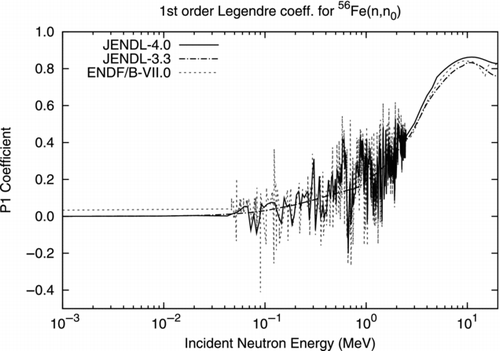
The number of fission product nuclides (Z = 30 – 68) is 215 in JENDL-4.0, while JENDL-3.3 contains 185 nuclides in the same range. Newly evaluated are the following nuclides: 64,65,66,67,68,70Zn, 86Rb, 84Sr, 90Y, 105Ru, 111Ag, 126Sb, 132Te, 130,135I, 140La, 143Ce, 151Pm, 157Eu, 153Gd, 160Tb, and 154,156,158,159,160,161,162,163,164Dy. The RRPs of 109 nuclides were updated, while the RRPs were given to half of the newly evaluated nuclides. Smooth cross sections, i.e., cross sections above the resonance region, were revised for 136 nuclides and newly evaluated for 30 nuclides by using the statistical model codes. The details of some evaluations are given elsewhere. [Citation80, Citation81, Citation82, Citation83, Citation84, Citation85, Citation86, Citation87, Citation88, Citation89] The data on Zn were newly evaluated [Citation80]. The RRPs of 64,66−68Zn were mainly based on the data measured at ORNL. The thermal (n, α) cross section of 65Zn was evaluated as 11 μb, which is about five orders of magnitude smaller than the capture cross section. The fast-neutron cross sections of Zn isotopes were evaluated by using the CCONE code. Figure shows the 64Zn(n, α) cross section. The RRPs of 90,91,94,96Zr were updated using the latest measurements. Neutron capture cross sections of Zr isotopes were calculated [Citation86] with the POD code above the resonance region. The data on 107,109,110m Ag were updated. In addition, new evaluation of 111Ag with a half-life of 7.45 d was carried out for the proper treatment of burn-up chain: 110Pd(n, γ)111Pd(β−) and 110m Ag(n, γ)111Ag. The calculated DDX of elemental silver is illustrated in Figure , where a small bump next to the elastic peak represents a collective excitation. Special care was taken for the resolved resonance region for 157Gd. Using the latest parameters [Citation90] at the 0.032-eV resonance as they are, the calculations almost reproduce the power distribution for the core with Gd2O3–UO2 fuel, but considerably overestimate [Citation91] the criticalities for the cores having Gd in water. After trial and error, we finally added the background cross section to the capture cross sections calculated from the parameters of Leinweber et al. [Citation90] below 0.1 eV. The fast-neutron cross sections of Gd isotopes were calculated with the CCONE code. The (n, 2n) cross section of 160Gd is shown in Figure .
Except for W, which was already mentioned above as a structural material, re-evaluations were performed for Hf isotopes, Pb isotopes, and 209Bi in the range of Z = 69–83. The data on 169Tm, Yb isotopes, 181,182Hf, Os isotopes, and 197Au were newly evaluated for JENDL-4.0. The production of the long-lived isotope 182Hf (a half life of 8.90 × 106y) has drawn attention from the viewpoint of waste disposal, and new evaluations were performed [Citation92] for 181,182Hf. As for 181Hf(n, γ), there exist only two experimental thermal cross sections [Citation93, Citation94],and JENDL-4.0 is based on the latest data [Citation93]. New evaluation was also made for 197Au, since the capture cross section of 197Au is regarded as a standard at thermal energy and in the energy region from 0.2 to 2.5 MeV. The thermal capture cross section at 300 K in JENDL-4.0 was evaluated to be 98.65, being almost equivalent to 98.70 b in ENDF/B-VII.0 and 98.66 b in the IAEA standard library [Citation95]. It is found from Figure that the 197Au(n, γ) cross section of JENDL-4.0 agrees with available experimental data and are comparable to the other libraries in the energy range from 0.2 to 2.5 MeV.
Figure 22 Radiative capture cross section of 197Au. The upper panel shows the ratio of JENDL-4.0 to the IAEA standard [Citation95], and the shaded area indicates the uncertainties derived from the IAEA standard
![Figure 22 Radiative capture cross section of 197Au. The upper panel shows the ratio of JENDL-4.0 to the IAEA standard [Citation95], and the shaded area indicates the uncertainties derived from the IAEA standard](/cms/asset/e8a015c9-ef23-4d5f-adb6-3061e5edc04a/tnst_a_785282_o_f0022g.gif)
The library JENDL-4.0 contains the data for 79 nuclides in the actinoid region. Thermal fission and capture cross sections were obtained by using available experimental data. In the case where no experimental data were available, the thermal cross sections were determined from the systematics of the neighboring nuclides. The resolved resonance parameters of 235U were taken from the work of Leal et al. [Citation67] for JENDL-3.3 in the energy region up to 2.25 keV. However, the benchmark analysis of the fast reactor with uranium fuel pointed out that the 235U(n, γ) cross section of JENDL might be too large in the keV region. Consequently, the upper boundary of the resolved resonance region of 235U was changed to 500 eV from 2.25 keV, although the same resolved resonance parameters as those of JENDL-3.3 were employed. The capture cross section of 235U was reduced to almost the same average values as those in JENDL-3.2. Figure shows the capture cross section of 235U in the energy region from 100 eV to 100 keV. The fission cross sections of 233,235,238U and 239,240,241Pu were obtained above the resolved resonance region by the simultaneous evaluation method like in the previous libraries. Experimental data of 235U fission were limited to new ones reported after 1981. The evaluated fission cross section of 235U is smaller than that of JENDL-3.3 in the energy region from several hundred keV to a few MeV, as seen in Figure . The fission cross section of 237Np was evaluated with the least-squares fitting to experimental data above the resonance region. For other Np isotopes, the CCONE calculations were adopted for nonresonant fission cross sections. Figure shows the fission cross section of 235,237,239Np. The isomeric ratio of 241Am capture cross section was changed from JENDL-3.3. The ratio of the ground state to the total (ground + metastable states) production of 242Am was fixed at 0.896 up to 0.1 eV, which was obtained by averaging experimental data at thermal energy. Above 1 eV, the isomeric ratio was calculated with the CCONE code and normalized to a value of 0.84 at 300 keV [Citation96]. The ratio data were connected linearly between 0.1 and 1 eV. The resolved resonance parameters of 242−248Cm were revised for JENDL-4.0. It is found from Figure that the measured fission cross section of 243Cm is well reproduced by JENDL-4.0.
Figures and were prepared for comparisons of the thermal cross sections of actinides among different JENDL general-purpose libraries. In the figures, the cross-section change from JENDL-4.0 is expressed in units of percent. The thermal capture cross section of 235U changes considerably as compared with those of the other reactions in Figure , although it is important for nuclear energy applications. Compared with the cross sections of major actinides, those of minor actinides change significantly.
Covariances are given for 95 nuclides, i.e., 10,11B, 14,15N, 16O, 23Na, 48Ti, 52,53Cr, 55Mn, 56Fe, 59Co, 58,60Ni, 90Zr, 209Bi, and all actinoids. Except for the actinoids, most of the covariances were taken from JENDL-3.3 or an additional work [Citation97]. The covariances of the cross sections of 235U were calculated from those of the RRPs provided by Leal (Leal LC. Private communication, 2009) in the energy region below 500 eV, and they are given in MF33. Figure shows the covariances of 235U thus obtained. For 233,235,238U and 239,240,241Pu, the covariance matrices of the fission cross sections were obtained by the simultaneous evaluation above the resonance region. For the data evaluated using the nuclear model calculations, the covariance matrices were estimated using the KALMAN code [Citation98]. As an example, the standard deviation of the 237Np(n, γ) cross section is illustrated in Figure .
The new library JENDL-4.0 consists of the following sublibraries: a) neutron reaction sublibrary for 406 nuclides which was described earlier, b) spontaneous fission product yield sublibrary for nine nuclides, c) neutron-induced fission product yield sublibrary for 31 nuclides, d) thermal scattering sublibrary for 15 nuclides selected from ENDF/B-VI.8 [Citation61] and ENDF/B-VII.0 [Citation29], e) photoatomic sublibrary for 100 elements taken from EPDL95 [Citation99], and f) electroatomic sublibrary for 100 elements taken from EEDL [Citation100]. The fission product yields are essentially based on those of ENDF/B-VII.0. Modifications were done so that the fission products and decay chains should be consistent with JENDL/FPD-2000 [Citation101]. Moreover, ternary fission was included.
4.2. JENDL special-purpose libraries
Necessities of the special-purpose libraries were discussed [Citation102] in the JNDC, and we started developing them in the late 1980s. Table gives the features of the JENDL special-purpose libraries, i.e., Actinoid File 2008 [Citation11] (JENDL/AC-2008), Activation Cross Section File 96 [Citation103] (JENDL/A-96), (α, n) Reaction Data File 2003 [Citation104, Citation105] (JENDL/AN-2003), (α, n) Reaction Data File 2005 [Citation106] (JENDL/AN-2005), Dosimetry File 91 [Citation107] (JENDL/D-91), Dosimetry File 99 [Citation108] (JENDL/D-99), FP Decay Data File 2000 [Citation101] (JENDL/FPD-2000), FP Decay Data File 2011 [Citation109] (JENDL/FPD-2011), FP Fission Yields Data File 2011 [Citation109] (JENDL/FPY-2011), Fusion File 99 [Citation57] (JENDL/F-99), Gas-Production Cross Section File 91 [Citation110] (JENDL/G-91), High Energy File 2004 [Citation111] (JENDL/HE-2004), High Energy File 2007 [Citation112] (JENDL/HE-2007), and Photonuclear Data File 2004 [Citation113] (JENDL/PD-2004). The motive and feature of each special-purpose library are described in the following subsections.
Table 3 Characteristics of JENDL special-purpose libraries.
4.2.1. JENDL/AC-2008
After JENDL-3.3 was released in 2002, the JENDL/AC-2008 library was intended to improve the quality of minor actinides as well as that of major actinides. The evaluation priority is listed in Table , where the priority was determined from the study [Citation114] on the prediction accuracy of nuclide generation and depletion using JENDL-3.2 and JENDL-3.3. The JENDL/AC-2008 library is a full evaluation containing not only cross sections but also other physical quantities such as resonance parameters and angular and energy distributions of emitted neutrons. Part of the library was taken over to JENDL-4.0.
Table 4 Priorities in the JENDL/AC-2008 evaluations. Nuclides are ranked from A (high) to E (low).
In the development of JENDL/AC-2008, data correction was systematically performed for 233,235,238U, 239,240,241Pu, and 237Np by considering the results of reactor benchmark tests on small fast reactors contained in ICSBEP [Citation115]. The evaluators introduced a concept of “Maximum Allowable Change (MAC),” which is a maximum value in percent to be allowed for parameters to change. In practice, the MAC was set to be 0.5%, which is well within the range of the accuracy of the differential nuclear data. A “constraining covariance matrix (CCM)” is used in place of the so-called “prior covariance matrix (PCM)” as a device to fulfill the requirement posed by MAC. The CCM was assumed to be diagonal, and values of its matrix elements were determined mostly by try-and-error basis to suppress the variation of parameters. The uncertainty in the integral data was determined based on ICSBEP. Ten parameters per nucleus were allowed to vary, i.e., the optical potential strengths (real strength and surface imaginary strength), a quadrupole deformation parameter, inner and outer fission barrier heights, a giant-dipole resonance parameter, a multiplication factor for the level density parameter at the saddle, and normalization parameters for the fission cross section, the capture cross section, and the number of prompt neutrons per fission. The sensitivities of the integral data to these parameters were calculated directly, and corrections were determined in terms of the maximum likelihood method. Therefore, 70 parameters were corrected. This procedure was thought to be efficient and promising. However, it was pointed out by a few reactor physicists that a consistent covariance matrix could not be produced together with the mean values by using the CCM and that the resultant covariances would be useless for reactor applications. Therefore, this method was not taken for the JENDL-4.0 evaluation.
4.2.2. JENDL/A-96
Development of JENDL/A-96 started in 1987 as one of the post JENDL-3 activities. This library aimed at fission and fusion applications. Selection of nuclides and reactions were done with the following criteria:
| • | The half-lives of the targets should be longer than 1 day; | ||||
| • | The half-lives of the residual nuclei should be longer than 1 day; | ||||
| • | In the case where the residual nuclei decay to the daughter nuclei having the half-lives larger than 1 day, the production of such residual nuclei is considered even though their half-lives are less than 1 day; | ||||
| • | The threshold energy should be less than 18 MeV; | ||||
| • | The reactions should be such as (n, γ), (n, n′), (n, p), (n, d), (n, t), (n, 3 He), (n, α), (n, 2n), (n, np), (n, nd), (n, nt), (n, nα), (n, 2p), and (n, 3n). | ||||
The statistical model codes GNASH [Citation45] and CASTHY [Citation20] were employed for the evaluation, although part of the data was taken from JENDL-3.2. As an example, the 134Ba(n, 2n)133m Ba (J π = 11/2−, T 1/2 = 38.93h) reaction cross sections are illustrated in Figure . In this case, total (n, 2n) cross section was taken from JENDL-3.2, and the isomeric ratio was obtained from the GNASH calculations.
4.2.3. JENDL/AN-2003 and JENDL/AN-2005
Nuclear data on neutron-production reactions induced by α-particle are required in the fields of design and operation of nuclear fuel-cycle facilities. Strong α-particles are emitted from trans-uranium nuclides accumulated in spent nuclear fuel, and then neutrons are produced by the (α, xn) reactions on light elements which are around the fuel. Intensity of emitted neutrons should be estimated for the safe transportation, storage and reprocessing of the spent fuel. Achieving this, the JENDL (α, n) Reaction Data Files 2003 and 2005 were produced. The file JENDL/AN-2003 contains the cross-section and neutron energy-distribution data on 6,7Li, 9Be, 10,11B, 12,13C, 14,15N, 17,18O, 19F, and 23Na. In JENDL/AN-2005, the data on 9Be were revised and those on 27Al and 28,29,30Si were newly evaluated, whereas the other data were taken from JENDL/AN-2003 without modifications.
Measured (α, n) reaction data on light nuclei often exhibit resonance structure below several MeV. In such energy regions, evaluations were based on experimental data or an approximate R-matrix [Citation40] analysis. Statistical-model codes were applied to evaluate cross sections in the higher energy region. The 9Be(α, xn) reaction cross section is shown in Figure , where the statistical-model calculations were adopted in the energy region above 10 MeV.
4.2.4. JENDL/D-91 and JENDL/D-99
A dosimetry file is a dataset of the neutron cross sections which are basically used for the determination of neutron flux/fluence and energy spectrum at specific neutron fields. The first version was released in 1991 as JENDL/D-91 which contained neutron-induced reactions cross sections and their covariances for 61 reactions. In JENDL/D-91, the covariances were taken from IRDF-85 [Citation116], although most of the cross sections were based on JENDL-3.1. A project for the second version JENDL/D-99 was undertaken to evaluate cross sections and covariances in a more consistent way. To achieve this, a least-squares fitting code GMA [Citation117] was employed. As a result, JENDL/D-99 contains the data on 67 reactions. Major dosimetry cross sections and their covariances for 34 reactions were simultaneously generated, although the covariances for the remaining 33 reactions were taken from JENDL/D-91. Integral tests were performed with the neutron fields of thermal and fast reactors and the T(d,n) and Li(d,n) neutron sources. As an example, Figure shows the ratio (C/E) of the calculated cross sections to the experimental ones obtained at the Japan Materials Testing Reactor (JMTR). In the figure, the results of JENDL/D-99 are compared with those of IRDF-90V2 [Citation118] that was available in 1999.
4.2.5. JENDL/FPD-2000 and JENDL/FPD-2011
Decay data are needed for the analysis of reactor decay heat. The JNDC FP Decay Data Libraries Version-1 [Citation119] and Version-2 [Citation60] were issued in 1983 and 1990, respectively. However, these libraries were compiled in a different format from other JENDLs; hence, they were not regarded as the members of the JENDL family. The ENDF-6 format [Citation23] version, JENDL/FPD-2000, was released in 2000 by incorporating spectral data.
The decay data included for a nuclide are decay modes, their Q-values and branching ratios, average decay energy values of beta-rays, gamma-rays, and α-particles, and their spectral data. The primary source of the decay data is Evaluated Nuclear Structure Data File (ENSDF) [Citation120], which is the internationally recognized data file of nuclear structure properties. The data in ENSDF, however, cover only measured ones. The data of the short-lived nuclides needed for the applications such as decay heat prediction are often incomplete or not measured. For such nuclides, a theoretical model calculation is applied to derive the needed data such as average decay energies and spectral data. The library JENDL/FPD-2000 contains the data for 1229 fission product nuclides: 142 stable and 1087 unstable nuclides. After the release of JENDL/FPD-2000, newly measured decay data have been accumulated. Among such new experimental activities, the total absorption gamma-ray spectroscopy (TAGS) [Citation121] is very useful to obtain beta strength functions. Using such experimental information newly obtained, JENDL/FPD-2011 was produced. The new library contains the data for 1284 fission product nuclides of which 124 nuclides are stable.
4.2.6. JENDL/FPY-2011
As mentioned earlier, we obtained the new decay data library JENDL/FPD-2011. The fission product yield sublibrary of JENDL-4.0 was produced using the decay data JENDL/FPD-2000. In order to be consistent with JENDL/FPD-2011, fission product yields were recalculated and the data were released as JENDL/FPY-2011. As an example, Figure shows the recalculated cumulative fission product yields from the 235U(n, f) reaction at 0.0253 eV.
4.2.7. JENDL/F-99
DDXs, i.e., energy–angle correlated spectra, are required for fusion neutronics calculations at 14 MeV. Although high-energy cross sections contained in JENDL-3.0/3.1 were greatly improved as compared with those of JENDL-2, continuous-energy neutron spectra did not necessarily fulfill the requirements from the fusion community. The DDXs were evaluated for 79 isotopes and 13 natural elements ranging from hydrogen to bismuth. The data given in JENDL-3.1 were combined with nuclear model calculations. The DDX data were generated by using the systematics of angular distributions of continuous-energy neutrons [Citation122, Citation123]. As a matter of fact, the results obtained for JENDL/F-99 were transferred to JENDL-3.3 completely.
4.2.8. JENDL/G-91
The library JENDL/G-91 was produced for a radiation damage study. In the library, the data of MT=203, 204, 205, 206, and 207 denote the cross sections for 1H production, 2H production, 3H production, 3He production, and 4He production, respectively. Partial cross sections were taken from JENDL-3.1 [Citation17], and they were adequately summed up.
4.2.9. JENDL/HE-2004 and JENDL/HE-2007
The needs of high-energy nuclear data come from various applications such as the design of an accelerator-driven transmutation system, radiation therapy, radioisotope production, and space development. In order to meet the needs, the JNDC decided to produce the JENDL high-energy file. The first version was released in 2004 with neutron- and proton-induced reactions on 66 nuclides. The incident energies cover the region up to 3 GeV. The second version, which was released in 2007, contains the neutron- and proton-induced reaction data on 106 nuclides. For evaluations, a hybrid calculation system combining available nuclear model codes and systematics-based codes was used to cover the very wide energy range. The statistical model code GNASH [Citation45] was used below the matching energy E c , which was set to be between 150 and 250 MeV, depending on a target nucleus. A microscopic simulation code, either JAM [Citation124] or JQMD [Citation125], was applied for energies above E c . The TOTELA code, which is based on the systematics [Citation126], was used for evaluation of the total, elastic, and reaction cross sections above 150–250 MeV. The systematics-based code FISCAL [Citation127] was applied to high-energy fission cross sections. For neutron-induced reactions, the evaluated data were merged with JENDL-3.3 [Citation19] below 20 MeV. The evaluated nat Fe(n, xα) cross section is illustrated in Figure .
4.2.10. JENDL/PD-2004
Nuclear data for photonuclear reactions are required in the fields of shielding design of high-energy electron accelerators and high-energy gamma-ray therapy. The nuclear photoabsorption process up to 140 MeV mainly takes place via excitation to the electric giant dipole resonance (GDR) or via disintegration of a proton–neutron pair (quasi-deuteron) in a nucleus. The latter process was proposed by Levinger [Citation128] and is called the quasi-deuteron model (QDM). The former process is dominant for incident photon energies up to about 40 MeV, while the latter process is dominant in the region from 40 to 140 MeV. Therefore, the photon absorption cross section can be expressed by a sum of GDR and QDM terms. In the case where measured absorption cross sections are available with high accuracy, a least-squares fitting method is applied to determine the cross sections. Nuclear model codes are applied to obtain branching ratios for particle-emission. The library JENDL/PD-2004 contains the data for 68 nuclides in the energy region up to 140 MeV. As an example, the 54Fe(γ, xn) reaction cross section is shown in Figure .
5. Concluding remarks
The JNDC and the NDC of JAEA/JAERI have promoted the development of a series of JENDLs for peaceful use of nuclear energy. Starting with JENDL-1 released in 1977, the general-purpose libraries have been continuously updated. The latest library JENDL-4.0 was released in 2010, and it contains the neutron-induced reaction data for 406 nuclides together with other sublibraries. On the other hand, the special-purpose libraries are intended for applications to specific fields such as neutron dosimetry, activation analysis, and so on. As the other type of nuclear data, we are participating in the international cooperation of updating ENSDF, from which JENDL/FPD-2000 and -2011 were derived.
The libraries JENDL (Japan), ENDF (USA) and JEFF (EU) are regarded as three major libraries in the world. They are competing with each other in order to improve the quality. Such competition is ultimately beneficial to users. We should continue updating the JENDL databases which are requisite for science and technology.
Acknowledgements
The author would like to thank all the people involved in the development of JENDLs. He is also grateful to Prof. J. Katakura and Dr. K. Suyama for encouraging him to write this review paper. Special thanks are due to Drs. O. Iwamoto, N. Iwamoto, and S. Kunieda, and Mr. M. Namekawa for providing graphs or numerical data for graph-plotting. The author wishes to thank Dr. T. Nakagawa for critical reading of this manuscript.
Notes
*1 No. of isotopes + no. of natural elements
*2 No. of nuclides containing secondary γ-ray production data
*3 No. of nuclides containing covariances
*4 No. of nuclides containing double-differential cross sections d 2σ/dE/dΩ
*5 At the time of release, the number was 84 nuclides without fission products. In 1985, the fission-product data for 97 nuclides were added to JENDL-2.
References
- Parker , K . 1963 . The Aldermaston nuclear data library as at May 1963 (AERE Report No. O-70/63) , Abingdon , , UK : United Kingdom Atomic Energy Authority .
- Schmidt , J J . 1966 . Neutron cross sections for fast reactor materials, Part I: evaluation, KFK . Kernforschungszentrum Karlsruhe , 120 Karlsruhe, Germany
- OECD/NEA Data Bank . 1985 . Index to the JEFF-1 nuclear data library , I (JEF Report 1). Paris, France
- Honeck , H C . 1966 . ENDF/B – Specifications for an evaluated nuclear data file for reactor applications, BNL . Brookhaven National Laboratory , 50066 Upton, NY
- Igrasi , S , Nakagawa , T , Kikuchi , Y , Asami , T and Narita , T . 1979 . Japanese evaluated nuclear data library, version-1 – JENDL-1 –, JAERI 1261 , Tokai , , Japan : Japan Atomic Energy Research Institute .
- Shibata , K , Iwamoto , O , Nakagawa , T , Iwamoto , N , Ichihara , A , Kunieda , S , Chiba , S , Furutaka , K , Otuka , N , Ohsawa , T , Murata , T , Matsunobu , H , Zukeran , A , Kamada , S and Katakura , J . 2011 . JENDL-4.0: a new library for nuclear science and engineering . J Nucl Sci Technol , 48 : 1 – 30 . doi: 10.1080/18811248.2011.9711675
- Chadwick , M B , Herman , M , Obložinský , P , Dunn , M , Danon , Y , Kahler , A C , Smith , D L , Pritychenko , B , Arbanas , G , Arcilla , R , Brewer , R , Brown , D A , Capote , R , Carlson , A D , Cho , Y S , Derrien , H , Guber , K , Hale , G M , Hoblit , S , Holloway , S , Johnson , T D , Kawano , T , Kiedrowski , B C , Kim , H , Kunieda , S , Larson , N M , Leal , L , Lestone , J P , Little , R C , McCutchan , E A , MacFarlane , R E , MacInnes , M , Mattoon , C M , McKnight , R D , Mughabghab , S F , Nobre , G PA , Palmiotti , G , Palumbo , A , Pigni , M T , Pronyaev , V G , Sayer , R O , Sonzogni , A A , Summers , N C , Talou , P , Thompson , I J , Trkov , A , Vogt , R L , van der Marck , S C , Wallner , A , White , M C , Wiadra , D and Young , P G . 2011 . ENDF/B-VII.1 nuclear data for science and technology: cross sections, covariances, fission product yields and decay data . Nucl Data Sheets , 112 : 2887 – 2996 . doi: 10.1016/j.nds.2011.11.002
- OECD Nuclear Energy Agency Data Bank . 2012 . Available from: http://www.oecd-nea.org/dbforms/data/eva/evatapes/jeff_31/JEFF312/
- IAEA Nuclear Data Section . 1993 . Available from: http://www-nds.iaea.org/ndspub/download-endf
- Ge , Z G , Zhao , Z X , Xia , H H , Zhuang , Y X , Liu , T J , Zhang , J S and Wu , H C . 2011 . The updated version of Chinese evaluated nuclear data library (CENDL-3.1) . J Korean Phys Soc. , 59 ( 2 ) : 1052 – 1056 . doi: 10.3938/jkps.59.1052
- Iwamoto , O , Nakagawa , T , Otuka , N , Chiba , S , Okumura , K , Chiba , G and Ohsawa , T . 2009 . Furutaka K. JENDL actinoid file 2008 . J Nucl Sci Technol. , 46 : 510 – 528 . doi: 10.1080/18811248.2007.9711557
- Sublet , J -Ch , Packer , L W , Kopecky , J , Forrest , R A , Koning , A J and Rochman , D A . 2010 . The European activation file: EAF-2010 neutron-induced cross section library, CCFE-R (10) 05 , Abingdon , , UK : EURATOM/CCFE Fusion Association, Culham Science Centre .
- Lópes Aldama , D and Trkov , A . 2004 . FENDL-2.1, Update of an evaluated nuclear data library for fusion applications, INDC(NDS)-467 , Vienna , , Austria : International Atomic Energy Agency .
- Zsolnay , E M , Capote Noy , R , Nolthenius , H J and Trkov , A . 2012 . Summary description of the new international reactor dosimetry and fusion file (IRDFF release 1.0), INDC(NDS)-0616 , Vienna , , Austria : International Atomic Energy Agency .
- Igarasi , S , Asami , T , Kikuchi , Y , Nakagawa , T , Narita , T and Shibata , K . 1984 . Report on second version of Japanese evaluated nuclear data library, JENDL-2 . J At Energy Soc Jpn. , 26 : 191 – 198 . doi: 10.3327/jaesj.26.191
- Shibata , K , Nakagawa , T , Asami , T , Fukahori , T , Narita , T , Chiba , S , Mizumoto , M , Hasegawa , A , Kikuchi , Y , Nakajima , Y and Igarasi , S . 1990 . Japanese evaluated nuclear data library, Version-3 – JENDL-3 –, JAERI 1319 , Tokai , , Japan : Japan Atomic Energy Research Institute .
- Asami , T , Iijima , S , Igarasi , S , Ihara , H , Kawai , M , Kikuchi , Y , Komuro , Y , Shibata , K , Takano , H , Takeda , T , Nakagawa , T , Nakazawa , M , Hasegawa , A , Maekawa , H , Mizumoto , M and Yoshida , T . 1989 . Japanese evaluated nuclear data library Version 3, JENDL-3 . J At Energy Soc Jpn , 31 : 1190 – 1217 . doi: 10.3327/jaesj.31.1190
- Nakagawa , T , Shibata , K , Chiba , S , Fukahori , T , Nakajima , Y , Kikuchi , Y , Kawano , T , Kanda , Y , Ohsawa , T , Matsunobu , H , Kawai , M , Zukeran , A , Watanabe , T , Igarasi , S , Kosako , K and Asami , T . 1995 . Japanese evaluated nuclear data library version 3 revision-2: JENDL-3.2 . J Nucl Sci Technol. , 32 : 1259 – 1271 . doi: 10.1080/18811248.1995.9731849
- Shibata , K , Kawano , T , Nakagawa , T , Iwamoto , O , Katakura , J , Fukahori , T , Chiba , S , Hasegawa , A , Murata , T , Matsunobu , H , Ohsawa , T , Nakajima , Y , Yoshida , T , Zukeran , A , Kawai , M , Baba , M , Ishikawa , M , Asami , T , Watanabe , T , Watanabe , Y , Igashira , M , Yamamuro , N , Kitazawa , H , Yamano , N and Takano , H . 2002 . Japanese evaluated nuclear data library version 3 revision-3: JENDL-3.3 . J Nucl Sci Technol. , 39 : 1125 – 1136 . doi: 10.1080/18811248.2002.9715303
- Igarasi , S and Fukahori , T . 1991 . Program CASTHY – Statistical model calculation for neutron cross sections and gamma ray spectrum –, JAERI 1321 , Tokai , , Japan : Japan Atomic Energy Research Institute .
- Nakagawa , T . 1984 . Program RESENDD (Version 84-07): A program for reconstruction of resonance cross sections from evaluated nuclear data in the ENDF/B format (modified version of RESEND), JAERI-M 84-192 , Tokai , , Japan : Japan Atomic Energy Research Institute .
- Kikuchi , Y , Nakagawa , T and Nakajima , Y . 1999 . ASREP: A computer program for automatic search of unresolved resonance parameters, JAERI-Data/Code 99-025 , Tokai , , Japan : Japan Atomic Energy Research Institute .
- Herman , M and Trkov , A . 2010 . ENDF-6 format manual, BNL-90365-2009 Rev.1 , Upton , NY : Brookhaven National Laboratory .
- Nakagawa , T . 1999 . CRECTJ: a computer program for compilation of evaluated nuclear data, JAERI-Data/Code 99-041 , Tokai , , Japan : Japan Atomic Energy Research Institute .
- Narita , T , Nakagawa , T , Kanemori , Y and Yamakoshi , H . 1974 . SPLINT: a computer code for superimposed plotting of the experimental and the evaluated data, JAERI-M 5769 , Tokai , , Japan : Japan Atomic Energy Research Institute .
- Garber , D . 1975 . ENDF-201 ENDF/B summary documentation, BNL 17541 , Upton , NY : Brookhaven National Laboratory .
- Lomon , E and Wilson , R . 1974 . Neutron-proton scattering at a few MeV . Phys Rev C , 9 : 1329 – 1335 . doi: 10.1103/PhysRevC.9.1329
- Hopkins , J C and Breit , G . 1971 . The 1H(n, n)1H scattering observables required for high-precision fast-neutron measurements . Nucl Data Tables A , 9 : 137 – 145 . doi: 10.1016/S0092-640X(71)80038-4
- Chadwick , M B , Obložinský , P , Herman , M , Greene , N M , McKnight , R D , Smith , D L , Young , P G , MacFarlane , R E , Hale , G M , Frankle , S C , Kahler , A C , Kawano , T , Little , R C , Madland , D G , Moller , P , Mosteller , R D , Page , P R , Talou , P , Trellue , H , White , M C , Wilson , W B , Arcilla , R , Dunford , C L , Mughagbhab , S F , Pritychenko , B , Rochman , D , Sonzogni , A A , Lubitz , C R , Trumbull , T H , Weinman , J P , Brown , D A , Cullen , D E , Heinrichs , D P , McNabb , D P , Derrien , H , Dunn , M E , Larson , N M , Leal , L C , Carlson , A D , Block , R C , Briggs , J B , Cheng , E T , Huria , H C , Zerkle , M L , Kozier , K S , Courcelle , A , Pronyaev , V and van der Marck , S C . 2006 . ENDF/B-VII.0: next generation evaluated nuclear data library for nuclear science and engineering . Nucl Data Sheets , 107 : 2931 – 3060 . doi: 10.1016/j.nds.2006.11.001
- Komoda , S and Igarasi , S . 1978 . Neutron cross sections of Li-6 . J Nucl Sci Technol. , 15 : 79 – 81 . doi: 10.1080/18811248.1978.9733203
- Kapur , P L and Peierls , R . 1938 . The dispersion formula for nuclear reactions . Proc R Soc A , 166 : 277 – 295 . doi: 10.1098/rspa.1938.0093
- Mughabghab , S F and Garber , D I . 1973 . Neutron cross sections , 3rd ed. , Vol. 1 , Upton , NY : Brookhaven National Laboratory . BNL-325
- Pearlstein , S . 1965 . Analysis of (n,2n) cross sections for medium and heavy mass nuclei . Nucl Sci Eng. , 23 : 238 – 250 .
- Ribon , P and Le Coq , G . 1971 . Evaluation des données neutroniques de 239Pu, CEA-N-1484 . Saclay; Commissariat à L’Energie Atomique ,
- Igarasi , S . 1977 . Neutron cross sections of americium-241 . J Nucl Sci Technol. , 14 : 1 – 11 . doi: 10.1080/18811248.1977.9730718
- Faddeev , L D . 1961 . Scattering theory for a three-particle system . Sov Phys JETP , 12 : 1014 – 1019 .
- Shibata , K , Narita , T and Igarasi , S . 1983 . Evaluation of neutron nuclear data for deuterium, JAERI-M 83-006 , Tokai , , Japan : Japan Atomic Energy Research Institute .
- Nakagawa , T . 1980 . Nuclear data evaluation system, NDES . J At Energy Soc Jpn. , 22 : 559 – 571 . doi: 10.3327/jaesj.22.559
- Matsunobu , H , Kanda , Y , Kawai , M , Murata , T and Kikuchi , Y . 1980 . “ Simultaneous evaluation of the nuclear data for heavy nuclides ” . In Proceedings of the International Conference on nuclear cross sections for technology , 715 – 719 . Knoxville : NBS Special Publication 594 . 1979 22–26 October
- Lane , A M and Thomas , R G . 1958 . R-matrix theory of nuclear reactions . Rev Mod Phys. , 30 : 257 – 353 . doi: 10.1103/RevModPhys.30.257
- Shibata , K . 1990 . Evaluation of neutron nuclear data for 3He and 4He . J Nucl Sci Technol. , 27 : 81 – 88 . doi: 10.1080/18811248.1990.9731154
- Borzakov , S B , Malecki , H , Pikel’ner , L B , Stempinski , M and Sharapov , ÉI . 1982 . Features of the departure from the 1/v law of the cross section for the reaction 3He(n, p)T. Excited level of the 4He nucleus . Sov J Nucl Phys. , 35 : 307 – 312 .
- Raynal , J . 1972 . Optical-model and coupled-channel calculations in nuclear physics, IAEA-SMR-9/8, ICTP International Seminar Course, Trieste, 1971 August 2–20 , 281 – 322 . International Atomic Energy Agency .
- Kunz , P D and Rost , E . 1993 . “ The distorted-wave born approximation ” . In Computational Nuclear Physics 2 , Edited by: Langanke , K , Maruhn , J A and Kooninn , S E . 88 – 107 . New York : Springer Verlag .
- Young , P G , Arthur , E D and Chadwick , M B . 1992 . Comprehensive nuclear model calculations: introduction to the theory and use of the GNASH code, LA-12343-MS , Los Alamos , NM : Los Alamos National Laboratory .
- Fu , C Y . 1980 . A consistent nuclear model for compound and precompound reactions with conservation of angular momentum, ORNL/TM-7042 , Oak Ridge , TN : Oak Ridge National Laboratory .
- Nakagawa , T , Iijima , S , Sugi , T and Nishigori , T . 1999 . PEGASUS: a preequilibrium and multi-step evaporation code for neutron cross section calculation, JAERI-Data/Code 99-031 , Tokai , , Japan : Japan Atomic Energy Research Institute .
- Kikuchi , Y , Shibata , K , Asami , T , Sugi , T , Yamakoshi , H and Kitajima , N . 1985 . Evaluation of neutron nuclear data of chromium, iron and nickel for fusion neutronics application . J Nucl Sci Technol. , 22 : 499 – 503 . doi: 10.1080/18811248.1985.9735687
- Kawai , M , Iijima , S , Nakagawa , T , Nakajima , Y , Sugi , T , Watanabe , T , Matsunobu , H , Sasaki , M and Zukeran , A . 1992 . JENDL3 fission product nuclear data library . J Nucl Sci Technol. , 29 : 195 – 213 . doi: 10.1080/18811248.1992.9731515
- Kanda , Y , Uenohara , Y , Murata , T , Kawai , M , Matsunobu , H , Nakagawa , T , Kikuchi , Y and Nakajima , Y . 1986 . “ Simultaneous evaluation of fission and capture cross sections and their covariances for heavy nuclei ” . In Proceedings of the International Conference Nuclear Data for Basic and Applied Science , 1567 – 1571 . New York : Gordon and Breach . 1985 May 13–17; Santa Fe.
- Kazakov , L E , Kononov , V N , Manturov , G N , Poletaev , E D , Bokhovko , M V , Timokhov , V M and Voevodskiy , A A . 1986 . Neutron capture cross-section measurements for U-238 in the energy range from 4 to 460 keV. Yad Konst. , 3 : 37 – 45 .
- Madland , D G and Nix , J R . 1982 . New calculation of prompt fission neutron spectra and average prompt neutron multiplicities . Nucl Sci Eng. , 81 : 213 – 271 .
- Verbinski , V V , Weber , H and Sund , R E . 1973 . Prompt gamma rays from 235U(n, f), 239Pu(n, f), and spontaneous fission of 252Cf . Phys Rev C , 7 : 1173 – 1185 . doi: 10.1103/PhysRevC.7.1173
- Maerker , R E . 1972 . SDT1: iron broomstick experiment – an experimental check of neutron total cross sections, ORNL/TM-3867 , Oak Ridge , TN : Oak Ridge National Laboratory .
- Maerker , R E . 1972 . SDT4: sodium broomstick experiment – an experimental check of neutron total cross sections, ORNL/TM-3870 , Oak Ridge , TN : Oak Ridge National Laboratory .
- Larson , D C , Harvey , J A and Hill , N W . 1976 . Measurement of the neutron total cross section of sodium from 32 keV to 37 MeV, ORNL/TM-5614 , Oak Ridge , TN : Oak Ridge National Laboratory .
- Chiba , S , Fukahori , T , Shibata , K , Yu , B S , Kosako , K and Yamamuro , N . 2002 . JENDL fusion file 99 . J Nucl Sci Technol. , 39 : 187 – 194 . doi: 10.1080/18811248.2002.9715174
- Muradyan , G V , Schepkin , Y uG , Adamchuk , Y uV and Voskanyan , M A . 1980 . “ A measurement of U-235 absolute alpha value in the neutron energy range from 0.1 to 30 keV ” . In Proceedings of the International Conferences on Nuclear Cross Sections for Technology , 488 – 490 . Knoxville : NBS Special Publication 594 . 1979 October 22–26;
- Shibata , K , Igarasi , S , Asami , T , Mizumoto , M , Igashira , M , Kitazawa , H and Hida , K . 1997 . Improvement of gamma-ray production data for JENDL-3.2 . J Nucl Sci Technol. , 34 : 503 – 509 . doi: 10.3327/jnst.34.503
- Tasaka , K , Katakura , J , Ihara , H , Yoshida , T , Iijima , S , Nakasima , R , Nakagawa , T and Takano , H . 1990 . JNDC nuclear data library of fission products – Second Version –, JAERI 1320 , Tokai , , Japan : Japan Atomic Energy Research Institute .
- Rose , P F . 1991 . ENDF/B-VI summary documentation , 4th ed. , Upton , NY : Brookhaven National Laboratory . BNL-NCS-17541
- OECD/NEA Data Bank . 2000 . The JEF-2.2 nuclear data library (JEFF Report 17) , Paris , , France : OECD/Nuclear Energy Agency .
- Perey , C M , Perey , F G , Harvey , J A , Hill , N W and Larson , N M . 1990 . 56Fe resonance parameters for neutron energies up to 850 keV, ORNL/TM-11742 , Oak Ridge , TN : Oak Ridge National Laboratory .
- Harun-ar-Rashid , A KM . 2000 . Study on neutron reaction cross sections for erbium isotopes up to 20 MeV , Tokyo , , Japan : Tokyo Institute of Technology . [Ph.D. Thesis]
- Shibata , K , Fukahori , T , Chiba , S and Yamamuro , N . 1997 . Evaluation of neutron nuclear data for mercury . J Nucl Sci Technol. , 34 : 1171 – 1177 . doi: 10.1080/18811248.1997.9733807
- Shibata , K . 2002 . Evaluation of neutron nuclear data for sodium-23 . J Nucl Sci Technol. , 39 : 1065 – 1071 . doi: 10.1080/18811248.2002.9715295
- Leal , L C , Derrien , H , Larson , N M and Right , R W . 1999 . R-matrix analysis of 235U neutron transmission and cross-section measurements in the 0- to 2.25-keV energy range . Nucl Sci Eng. , 131 : 230 – 253 .
- Ohsawa , T . 2001 . New evaluation of prompt neutron spectra of U-235 and Pu-239 for JENDL-3.3. In Proceedings of the 2000 Symposium Nuclear Data; 2000 November 16–17; Tokai, JAERI-Conf 2001-006 , 157 – 161 . Tokai , , Japan : Japan Atomic Energy Research Institute .
- Kawano , T , Matsunobu , H , Murata , T , Zukeran , A , Nakajima , Y , Kawai , M , Iwamoto , O , Shibata , K , Nakagawa , T , Ohsawa , T , Baba , M and Yoshida , T . 2000 . Simultaneous evaluation of fission cross sections of uranium and plutonium isotopes for JENDL-3.3 . J Nucl Sci Technol. , 37 : 327 – 334 . doi: 10.1080/18811248.2000.9714902
- Shibata , K . 1989 . Calculation of neutron-induced reaction cross sections of manganese-55 . J Nucl Sci Technol. , 26 : 955 – 965 . doi: 10.1080/18811248.1989.9734411
- Shibata , K , Hasegawa , A , Iwamoto , O , Chiba , S , Sugimoto , M , Odano , N , Kawano , T , Nakajima , Y , Murata , T , Matsunobu , H , Oh , S Y , Yokoyama , K , Sugino , K , Ishikawa , M , Kosako , K , Yamano , N and Kanda , Y . 2002 . JENDL-3.2 covariance file . J Nucl Sci Technol. , 2 : 40 – 43 . Supplement
- Iwamoto , O . 2007 . Development of a comprehensive code for nuclear data evaluation, CCONE, and validation using neutron-induced cross sections for uranium isotopes . J Nucl Sci Technol. , 44 : 687 – 697 . doi: 10.1080/18811248.2007.9711857
- Ichihara , A , Iwamoto , O , Chiba , S , Kunieda , S and Shibata , K . 2007 . Program POD: a computer code to calculate cross sections for neutron-induced nuclear reactions, JAEA-Data/Code 2007-012 , Tokai , , Japan : Japan Atomic Energy Agency .
- Kunieda , S , Chiba , S , Shibata , K , Ichihara , A and Sukhovitskiĩ , E Sh . 2007 . Coupled-channels optical model analyses of neutron-induced reactions for medium and heavy nuclei in the energy region from 1 keV to 200 MeV . J Nucl Sci Technol. , 44 : 838 – 852 . doi: 10.1080/18811248.2007.9711321
- Kunieda , S , Chiba , S , Shibata , K , Ichihara , A , Iwamoto , O , Iwamoto , N , Fukahori , T and Sukhovitskiĩ , E Sh . 2009 . Extensive study of the soft-rotator Hamiltonian parameters for medium and heavy even–even nuclei . J Nucl Sci Technol. , 46 : 914 – 924 . doi: 10.1080/18811248.2009.9711600
- Iwamoto , O . 2008 . Systematics of prompt fission neutron spectra . J Nucl Sci Technol. , 45 : 910 – 919 . doi: 10.1080/18811248.2008.9711492
- Goto , M , Shimakawa , S and Nakao , Y . 2011 . Impact of revised thermal neutron capture cross section of carbon stored in JENDL-4.0 on HTTR criticality calculation . J Nucl Sci Technol. , 48 : 965 – 969 . doi: 10.1080/18811248.2011.9711783
- Shibata , K and Kunieda , S . 2008 . Calculation of neutron nuclear data on silicon isotopes for JENDL-4 . J Nucl Sci Technol. , 45 : 123 – 137 . doi: 10.1080/18811248.2008.9711422
- Shibata , K . 2007 . Calculation of neutron nuclear data on calcium isotopes for JENDL-4 . J Nucl Sci Technol. , 44 : 10 – 20 . doi: 10.1080/18811248.2007.9711251
- Iwamoto , N . 2007 . New evaluation of neutron nuclear data for zinc isotopes . J Nucl Sci Technol. , 44 : 1131 – 1141 . doi: 10.1080/18811248.2007.9711356
- Shibata , K , Chiba , G , Ichihara , A and Kunieda , S . 2010 . Evaluation of neutron nuclear data on arsenic-75 for JENDL-4 . J Nucl Sci Technol. , 47 : 40 – 46 . doi: 10.1080/18811248.2010.9711925
- Kamada , S , Shibata , K , Ichihara , A and Kunieda , S . 2010 . Calculation of neutron nuclear data on selenium isotopes for JENDL-4 . J Nucl Sci Technol. , 47 : 329 – 339 . doi: 10.1080/18811248.2010.9711962
- Shibata , K , Ichihara , A and Kunieda , S . 2011 . Evaluation of neutron nuclear data on bromine and krypton isotopes for JENDL-4.0 . J Nucl Sci Technol. , 48 : 429 – 439 . doi: 10.1080/18811248.2011.9711717
- Shibata , K , Ichihara , A and Kunieda , S . 2010 . Calculation of neutron nuclear data on rubidium and strontium isotopes for JENDL-4 . J Nucl Sci Technol. , 47 : 1055 – 1064 . doi: 10.1080/18811248.2010.9711670
- Ichihara , A , Kunieda , S and Shibata , K . 2009 . Calculation of neutron cross sections on 89Y for JENDL-4 . J Nucl Sci Technol. , 46 : 252 – 258 . doi: 10.1080/18811248.2007.9711528
- Ichihara , A , Kunieda , S and Shibata , K . 2009 . Calculation of neutron cross sections on 90,91,92,94,96Zr for JENDL-4 . J Nucl Sci Technol. , 46 : 1076 – 1084 . doi: 10.1080/18811248.2009.9711618
- Ichihara , A , Kunieda , S and Shibata , K . 2008 . Calculation of neutron cross sections on 93Nb for JENDL-4 . J Nucl Sci Technol. , 45 : 793 – 801 . doi: 10.1080/18811248.2008.9711480
- Shibata , K , Ichihara , A and Kunieda , S . 2009 . Calculation of neutron nuclear data on molybdenum isotopes for JENDL-4 . J Nucl Sci Technol. , 46 : 278 – 288 . doi: 10.1080/18811248.2007.9711531
- Iwamoto , N . 2011 . Neutron nuclear data evaluation of cesium isotopes for JENDL-4.0 . J Nucl Sci Technol. , 48 : 1238 – 1249 . doi: 10.1080/18811248.2011.9711812
- Leinweber , G , Barry , D P , Trbovich , M J , Burke , J A , Drindak , N J , Knox , H D , Ballad , R V , Block , R C , Danon , Y and Severnyak , L I . 2006 . Neutron capture and total cross-section measurements and resonance parameters of gadolinium . Nucl Sci Eng. , 154 : 261 – 279 .
- Chiba , G , Okumura , K , Sugino , K , Nagaya , Y , Yokoyama , K , Kugo , T , Ishikawa , M and Okajima , S . 2011 . JENDL-4.0 benchmarking for fission reactor applications . J Nucl Sci Technol. , 48 : 172 – 187 . doi: 10.1080/18811248.2011.9711692
- Shibata , K . 2010 . Evaluation of neutron nuclear data on hafnium isotopes for JENDL-4 . J Nucl Sci Technol. , 47 : 160 – 168 . doi: 10.1080/18811248.2010.9711941
- Qiu , J Z , Yin , X Y , He , M , Dong , K J , Zhang , C H , Zhang , J S , Deng , H , Chen , X L and Jiang , S . 2005 . Measurement of cross-section for 181Hf(n, γ)182Hf reaction . High Energy Phys Nucl Phys. , 29 : 648 – 650 .
- Wing , J , Swartz , B A and Huizenga , J R . 1961 . New hafnium isotope, 182Hf . Phys Rev. , 123 : 1354 – 1355 . doi: 10.1103/PhysRev.123.1354
- Carlson , A D , Pronyaev , V G , Smith , D L , Larson , N M , Zhenpeng , C , Hale , G M , Hambsch , F -J , Gai , E V , Oh , S Y , Badikov , S A , Kawano , T , Hofmann , H M , Vonach , H and Tagesen , S . 2009 . International evaluation of neutron cross section standards . Nucl Data Sheets , 110 : 3215 – 3324 . doi: 10.1016/j.nds.2009.11.001
- Dovbenko , A G , Ivanov , V I , Kolesov , V E and Tolstikov , V A . 1971 . Radiative capture of neutrons by 241Am, LA-TR-71-74 , 1 – 9 . Los Alamos , NM : Los Alamos National Laboratory .
- Shibata , K and Nakagawa , T . 2007 . Uncertainty analyses of neutron cross sections for nitrogen-15, lead-206,207,208, bismuth-209, plutonium-238, americium-242m, and curium-244 in JENDL-3.3 . J Nucl Sci Technol. , 44 : 1 – 9 . doi: 10.1080/18811248.2007.9711250
- Kawano , T and Shibata , K . 1997 . Covariance evaluation system, JAERI-Data/Code 97-037 , Tokai , , Japan : Japan Atomic Energy Research Institute .
- Cullenr , D E , Hubbell , J H and Kissel , L D . 1997 . EPDL97: the evaluated photon data library, ’97 version . UCRL-50400. Livermore, CA: Lawrence Livermore National Laboratory , 6 Rev. 5
- Perkins , S T , Cullen , D E and Seltzer , S M . 1991 . Tables and graphs of electron-interaction cross sections from 10 eV to 100 GeV derived from the LLNL evaluated electron data library (EEDL). Z = 1–100 , Vol. 31 , Livermore , CA : Lawrence Livermore National Laboratory . UCRL-50400
- Katakura , J , Yoshida , T , Oyamatsu , K and Tachibana , T . 2001 . JENDL FP decay data file 2000, JAERI 1343 , Tokai , , Japan : Japan Atomic Energy Research Institute .
- Iijima , S , Katakura , J , Nakazawa , M , Kawai , M , Asami , T and Nakagawa , T . 1987 . “ JENDL special purpose data files ” . In Proceedings of the 1986 Seminar on nuclear data; 1986 November 26–27; Tokai; JAERI-M 87-025 , 230 – 240 . Tokai , , Japan : Japan Atomic Energy Research Institute .
- Nakajima , Y . 1990 . “ JENDL activation cross section file ” . In Proceedings of the 1990 Symposium on nuclear data , 43 – 57 . Tokai , , Japan : Japan Atomic Energy Agency . November 29–30Tokai; JAERI-M 91-032
- Murata , T and Shibata , K . 2002 . Evaluation of the (α, n) reaction nuclear data for light nuclei . J Nucl Sci Technol. , : 76 – 79 .
- Matsunobu , H and Yamamuro , N . 2002 . Evaluation of the nuclear data on (α, n) reaction for F, Na, Al, Cr, Fe, Ni, and Cu . J Nucl Sci Technol. , : 188 – 191 .
- Murata , T , Matsunobu , H and Shibata , K . 2006 . Evaluation of the (α, xn) reaction data for JENDL/AN-2005, JAEA-Research 2006-052 , Tokai , , Japan : Japan Atomic Energy Agency .
- Nakazawa , M , Kobayashi , K , Iwasaki , S , Iguchi , T , Sakurai , K , Ikeda , Y and Nakagawa , T . 1992 . JENDL dosimetry file, JAERI 1325 , Tokai , , Japan : Japan Atomic Energy Research Institute .
- Kobayashi , K , Iguchi , T , Iwasaki , S , Aoyama , T , Shimakawa , S , Ikeda , Y , Odano , N , Sakurai , K , Shibata , K , Nakagawa , T and Nakazawa , M . 2002 . JENDL dosimetry file 99 (JENDL/D-99), JAERI 1344 , Tokai , , Japan : Japan Atomic Energy Research Institute .
- Katakura , J . 2012 . JENDL FP decay data file 2011 and fission yields data file 2011, JAEA-Data/Code 2011-025 , Tokai , , Japan : Japan Atomic Energy Agency .
- Nakagawa , T and Narita , T , eds. 1992 . JENDL gas-production cross section file, JAERI-M 92-076 , Tokai , , Japan : Japan Atomic Energy Research Institute .
- Watanabe , Y , Fukahori , T , Kosako , K , Shigyo , N , Murata , T , Yamano , N , Hino , T , Maki , K , Nakashima , H , Odano , N and Chiba , S . 2005 . “ Nuclear data evaluations for JENDL high-energy file ” . In Proceedings of the International Conferences on nuclear data for science and technology , 326 – 331 . New York : AIP Conference Proceedings . 2004 September 26 – October 1; Santa Fe.
- Watanabe , Y , Kosako , K , Kunieda , S , Chiba , S , Fujimoto , R , Harada , H , Kawai , M , Maekawa , F , Murata , T , Nakashima , H , Niita , K , Shigyo , N , Shimakawa , S , Yamano , N and Fukahori , T . 2011 . Status of JENDL high energy file . J Korean Phys Soc. , 59 ( 2 ) : 1040 – 1045 . doi: 10.3938/jkps.59.1040
- Kishida , N , Murata , T , Asami , T , Kosako , K , Maki , K , Harada , H , Lee , Y O , Chang , J , Chiba , S and Fukahori , T . 2005 . “ JENDL photonuclear data file ” . In Proceedings of the International Conferences on nuclear data for science and technology , 199 – 202 . New York : AIP Conference Proceedings . 2004 September 26 – October 1; Santa Fe.
- Okumura , K , Ohki , S , Yamamoto , M , Matsumoto , H , Ando , Y , Tsujimoto , K , Sasahara , A , Katakura , J , Matsumura , T , Aoyama , T , Aoyama , M , Kaneko , T , Kosaka , S , Suyama , K and Naito , Y . 2004 . Study on the prediction accuracy of nuclide generation and depletion with JENDL, JAERI-Research 2004-025 , Tokai , , Japan : Japan Atomic Energy Research Institute .
- The International Criticality Safety Benchmark Evaluation Project . 2012 . [cited 2012 December]. Available from: http://icsbep.inel.gov/
- Cullen , D E , Kocherov , N and McLaughlin , P M . 1982 . The international reactor dosimetry file (IRDF-82), IAEA-NDS-41/R, rev.0 . International Atomic Energy Agency , IRDF-85 is a modified version with additional cross section data.
- Poenitz , W P . 1981 . Data interpretation, objective evaluation procedures and mathematical techniques for the evaluation of energy-dependent ratio, shape and cross section data . Proceedings on the Conference nuclear data evaluation methods and procedures , I : 249 – 289 . 1980 September 22–25; Upton,. BNL-NCS-51363
- Kocherov , N P and McLaughlin , P K . 1999 . The international reactor dosimetry file (IRDF-90 Version 2), IAEA-NDS-141 Rev. 4 , Vienna , , Austria : International Atomic Energy Agency .
- Tasaka , K , Ihara , H , Akiyama , M , Yoshida , T , Matumoto , Z and Nakashima , R . 1983 . JNDC nuclear data library of fission products, JAERI 1287 , Tokai , , Japan : Japan Atomic Energy Research Institute .
- Bhat , M R . 1992 . “ Evaluated nuclear structure data file (ENSDF) ” . In Proceedings of the International Conference nuclear data for science and technology , 817 – 821 . Berlin : Springer Verlag . 1991 May 13–17; Jülich.
- Helmer , R G , Putnam , M H , Greenwood , R C and Willmes , H . 1984 . Methodology for the measurement of β−-decay intensity distributions from the analysis of total absorption γ-ray spectra . Nucl Instrum Meth Phys Res A , 351 : 406 – 422 . doi: 10.1016/0168-9002(94)91370-6
- Kumabe , I , Watanabe , Y , Nohtomi , Y and Hanada , M . 1990 . Systematics and parameterization of continuum angular distributions for application to reactions induced by 14-MeV neutrons . Nucl Sci Eng. , 104 : 280 – 287 .
- Kalbach , C . 1988 . Systematics of continuum angular distributions: extensions to higher energies . Phys Rev C , 37 : 2350 – 2370 . doi: 10.1103/PhysRevC.37.2350
- Nara , Y , Otuka , N , Ohnishi , A , Niita , K and Chiba , S . 1999 . Relativistic nuclear collisions at 10A GeV energies from p+Be to Au+Au with the hadronic cascade model . Phys Rev C , 61 : 024901-1 – 024901-19 . doi: 10.1103/PhysRevC.61.024901
- Niita , K , Chiba , S , Maruyama , T , Maruyama , T , Takada , H , Fukahori , T , Nakahara , Y and Iwamoto , A . 1995 . Analysis of the (N, xN′) reactions by quantum molecular dynamics plus statistical decay model . Phys Rev C , 52 : 2620 – 2635 . doi: 10.1103/PhysRevC.52.2620
- Niita , K . 2000 . “ High energy nuclear reaction code JAM ” . In Proceedings of the 1999 Symposium on nuclear data , 98 – 103 . Japan Atomic Energy Research Institute . 1999 November 18–19; Tokai, JAERI-Conf 2000-005
- Fukahori , T , Watanabe , Y , Yoshizawa , N , Maekawa , F , Meigo , S , Konno , C , Yamano , N , Konobeyev , A Y and Chiba , S . 2002 . JENDL high energy file . J Nucl Sci Technol. , : 25 – 30 .
- Levinger , J S . 1951 . The high energy nuclear photoeffect . Phys Rev. , 84 : 43 – 51 . doi: 10.1103/PhysRev.84.43
